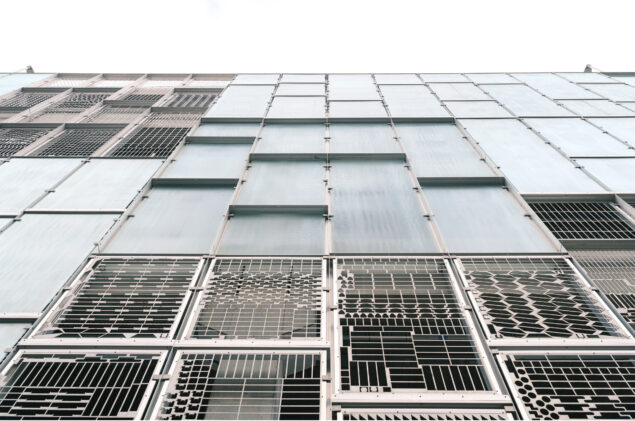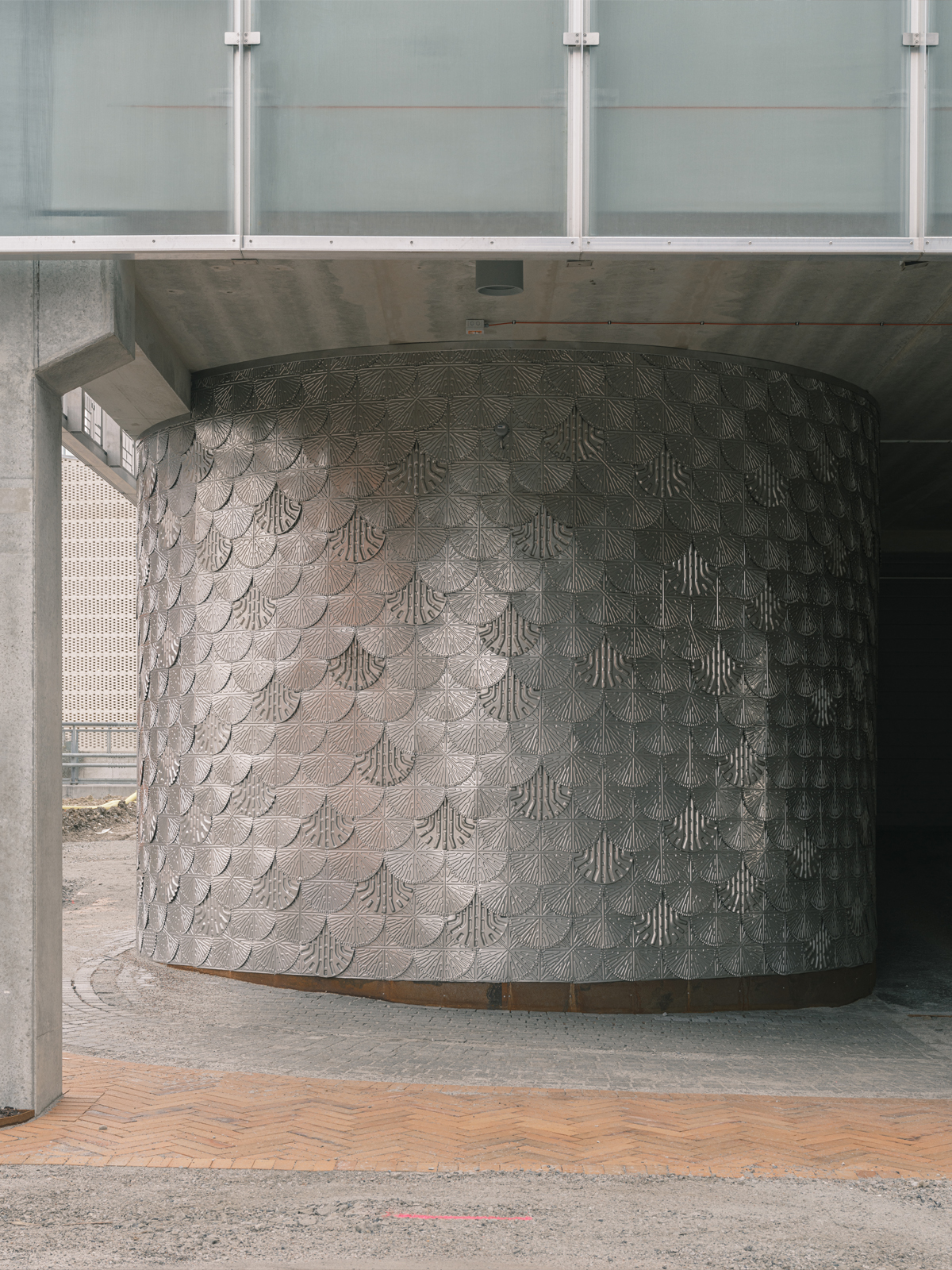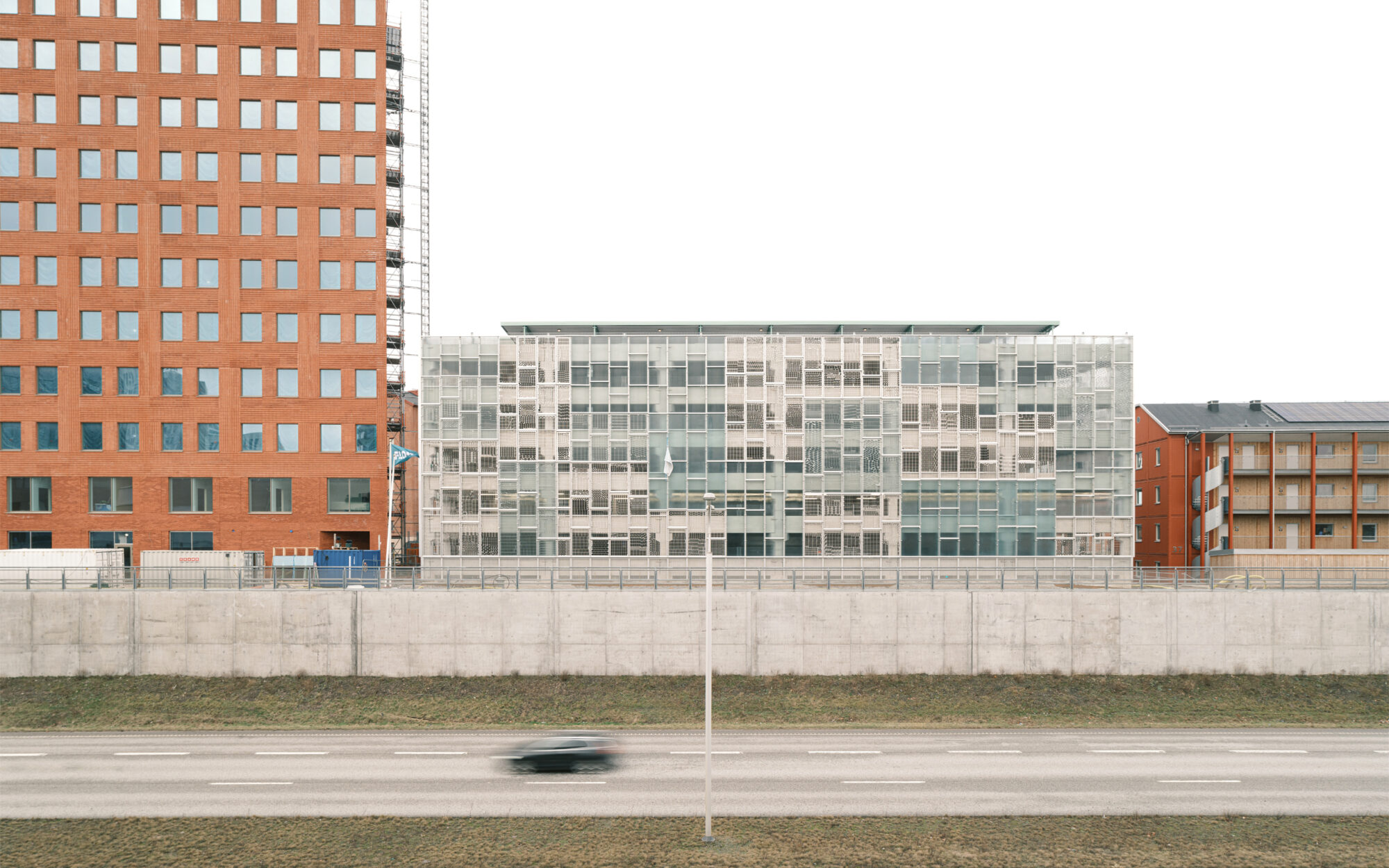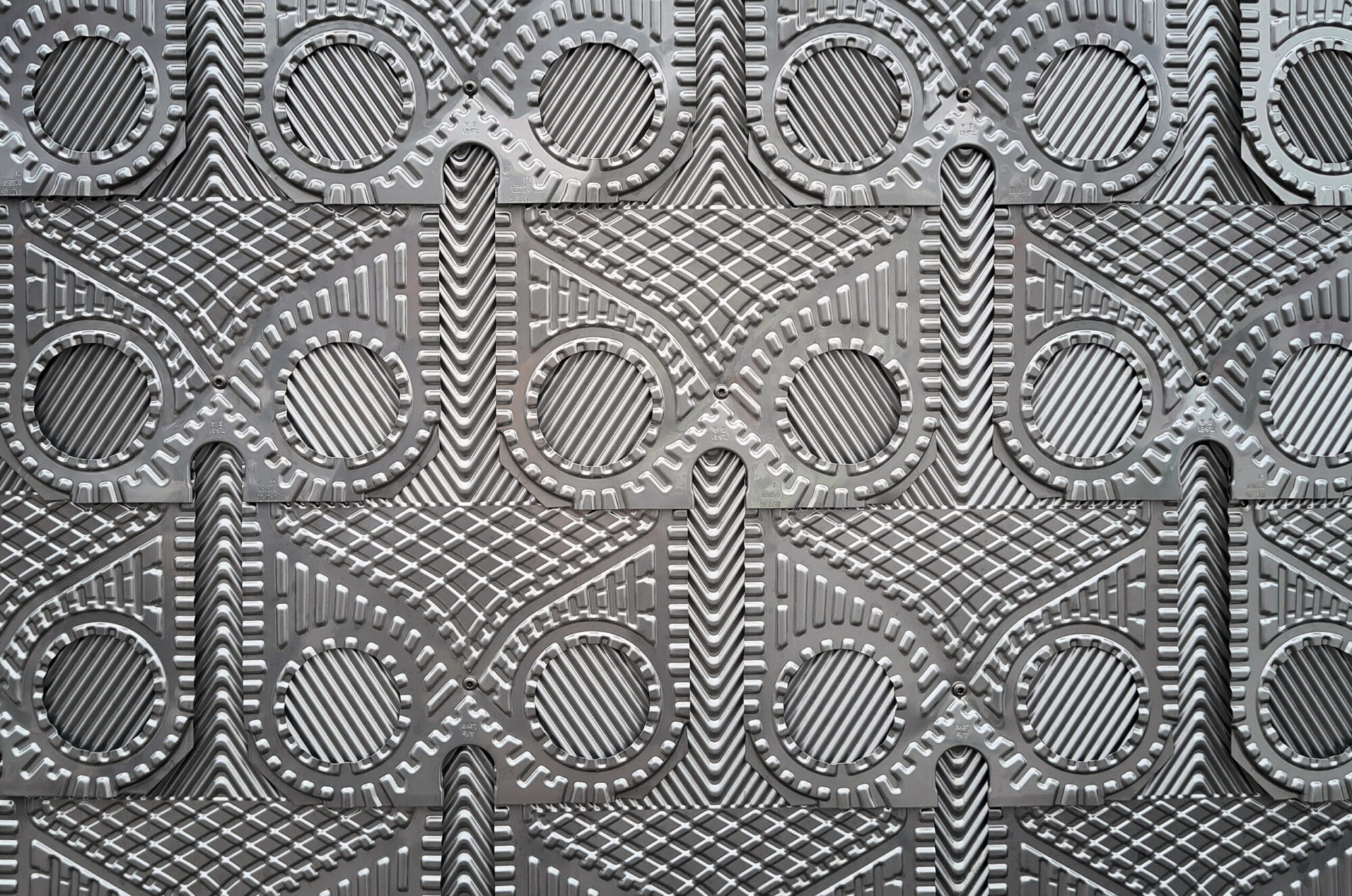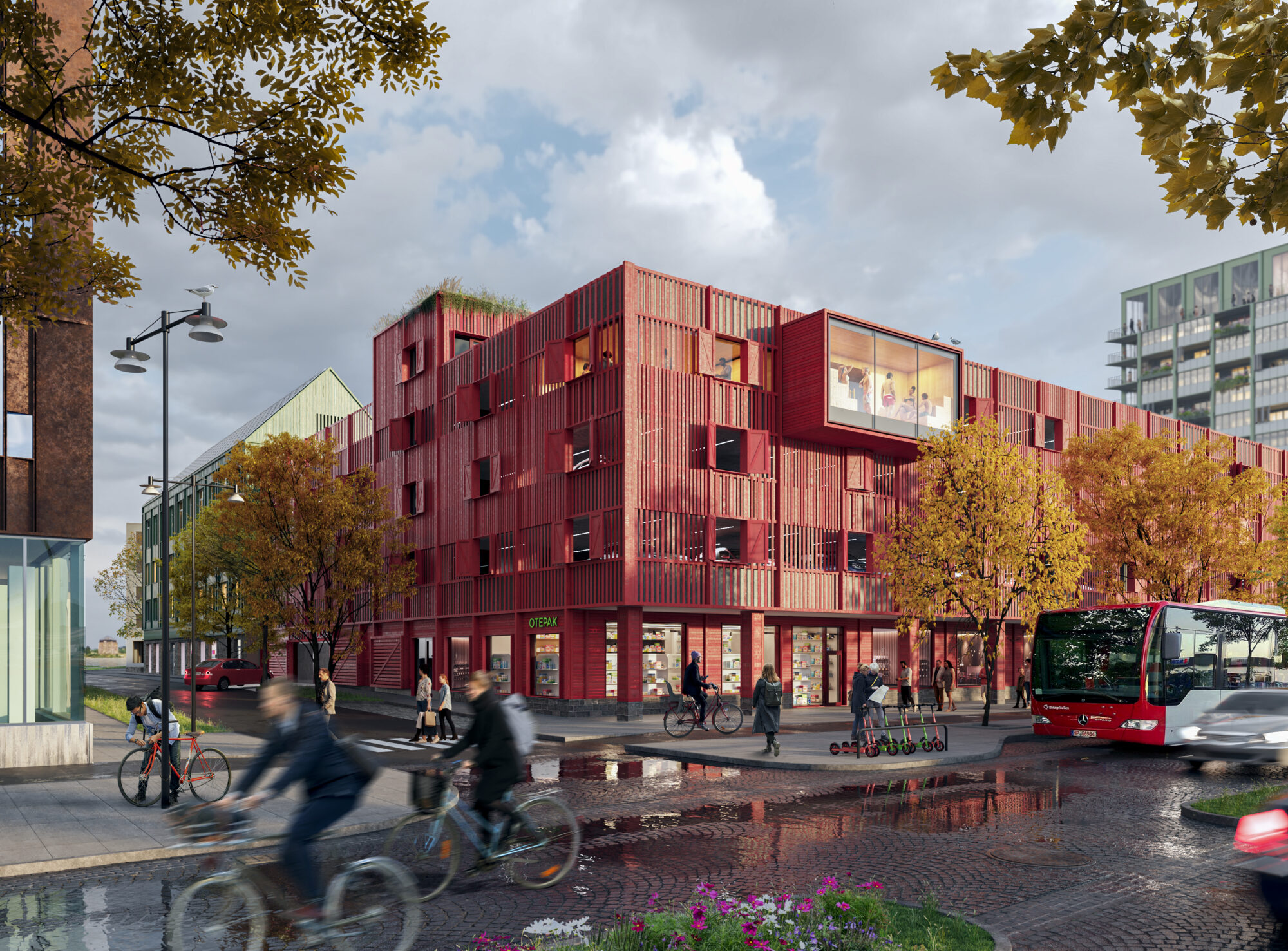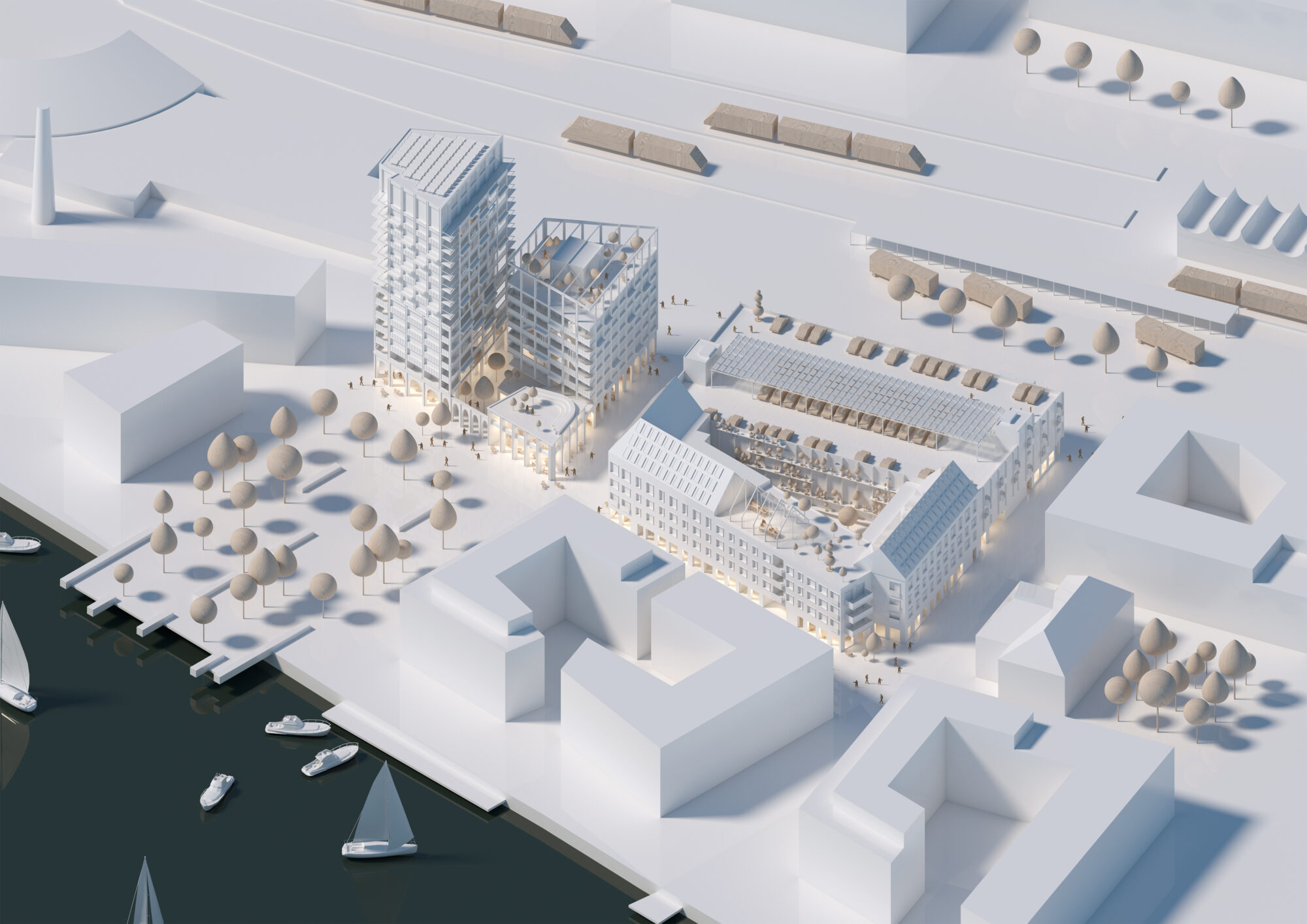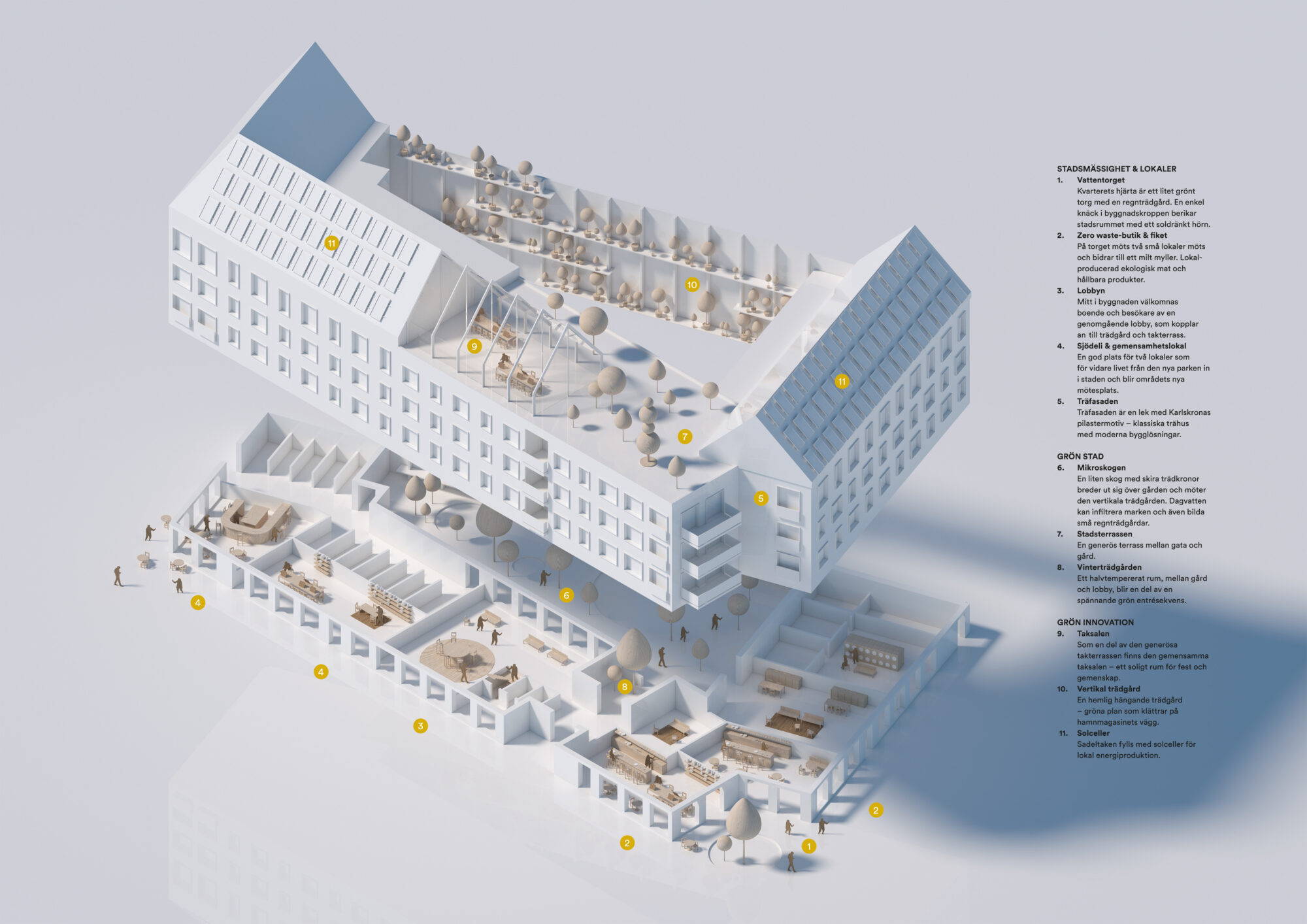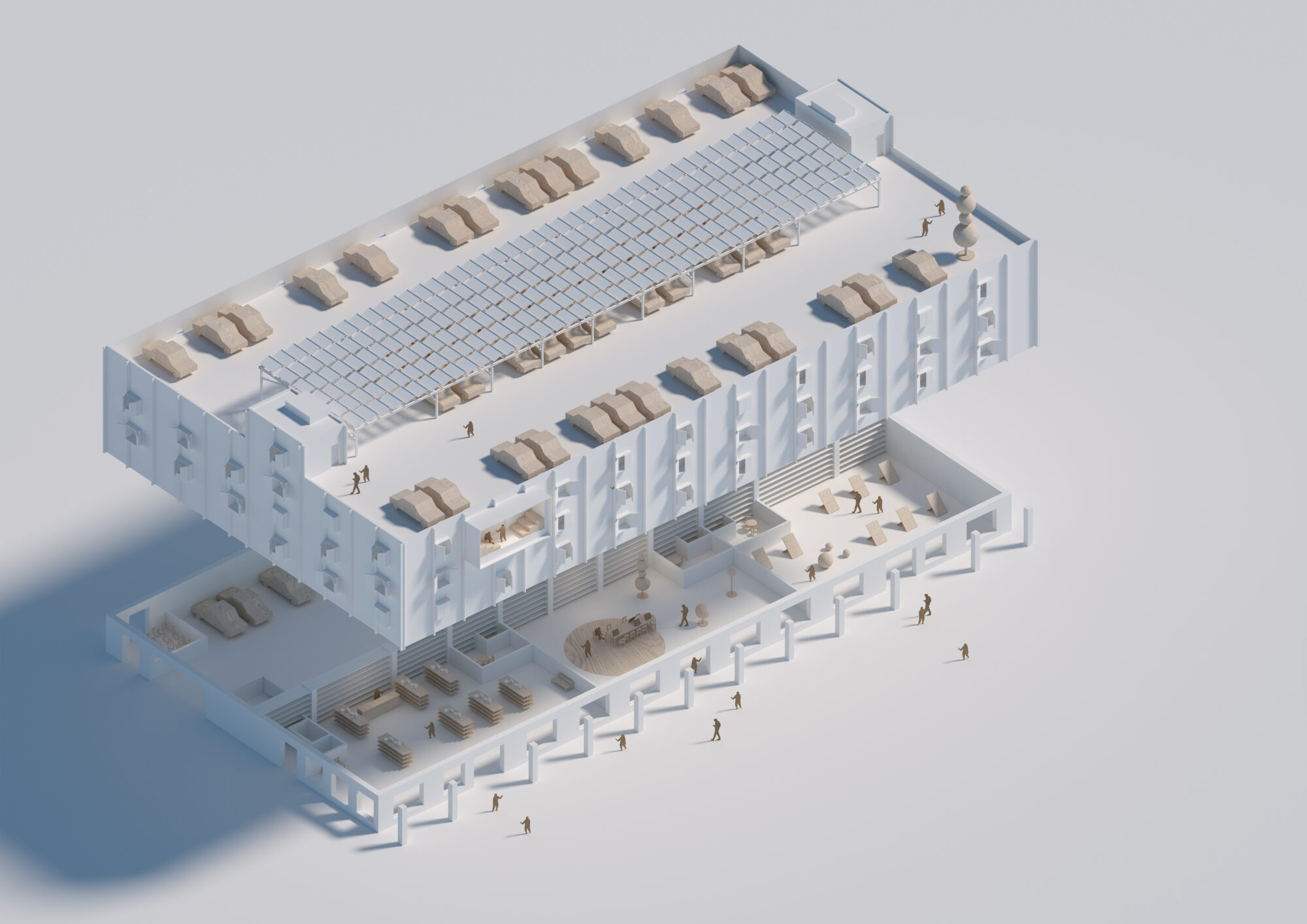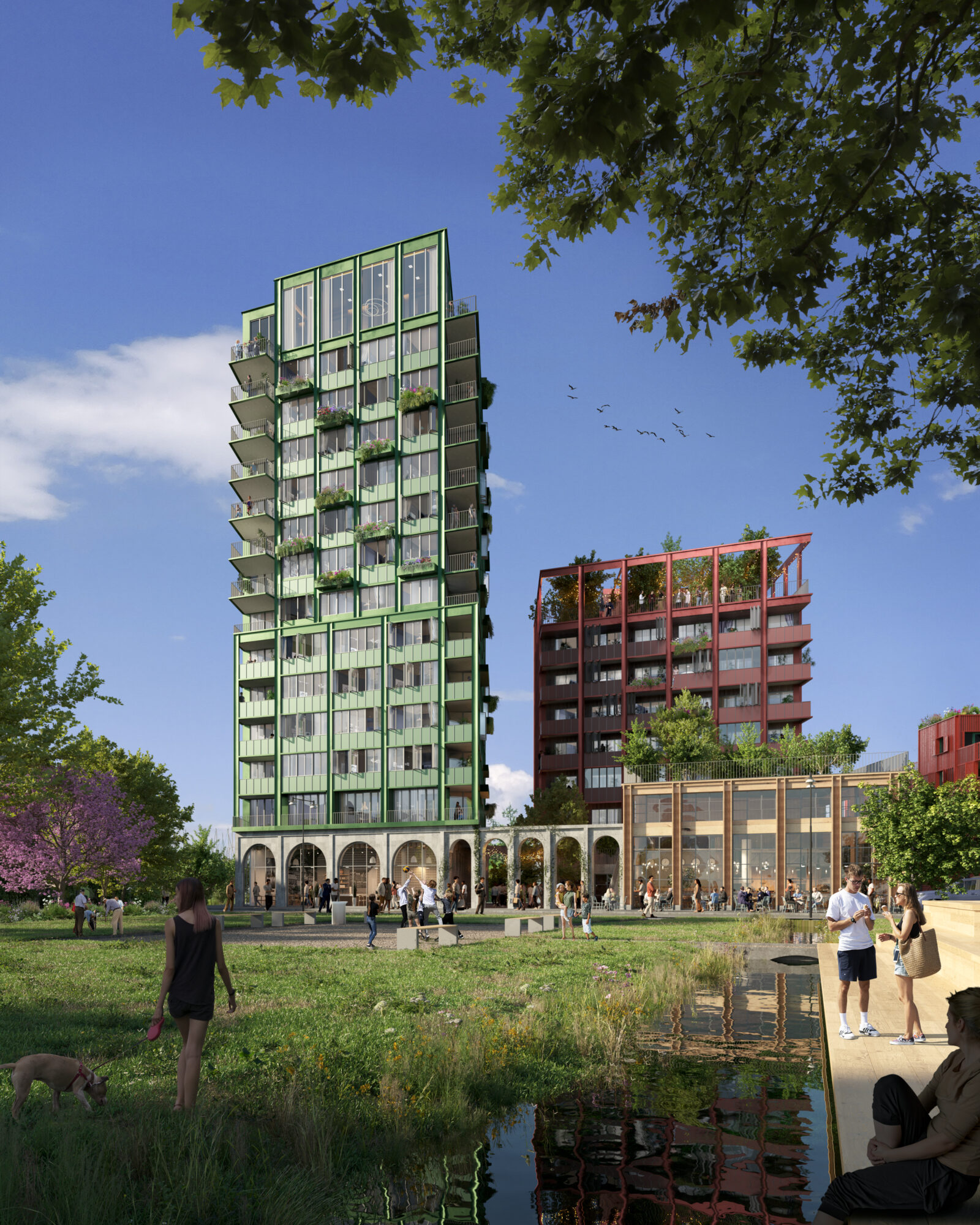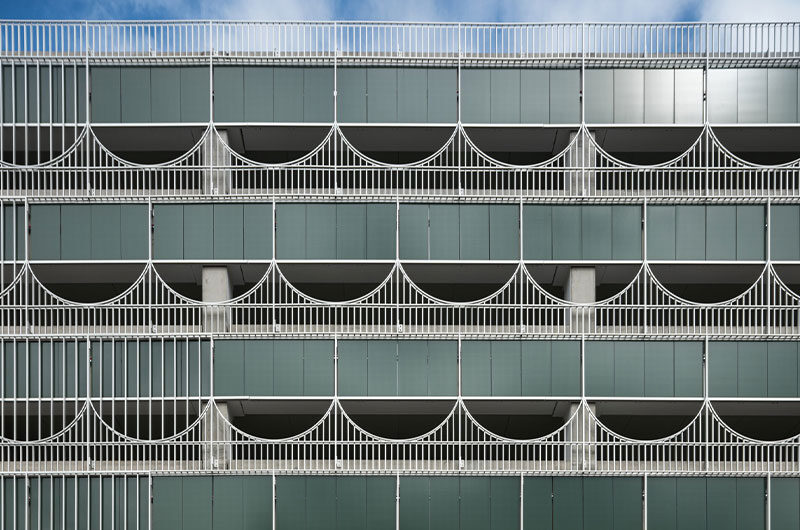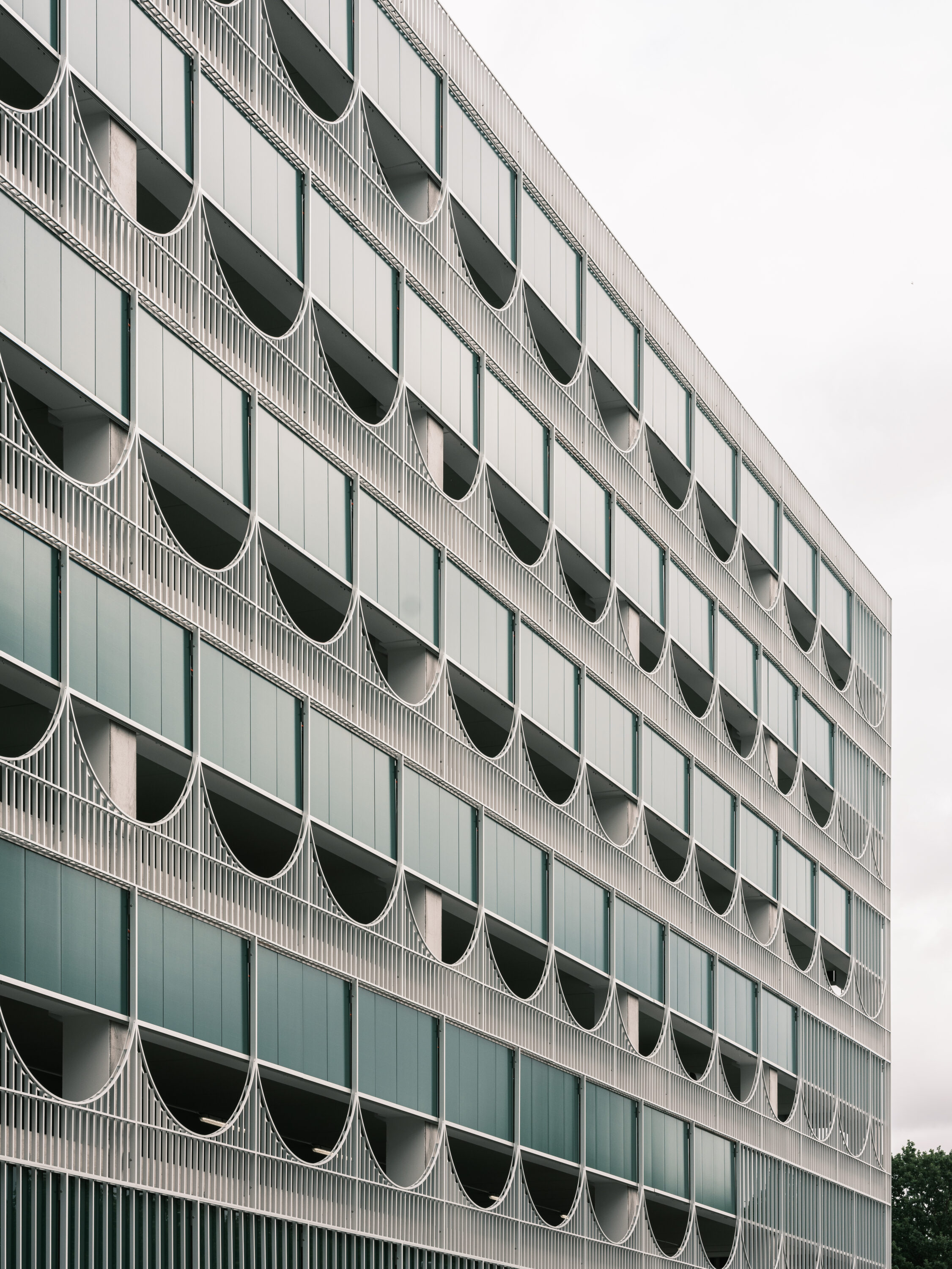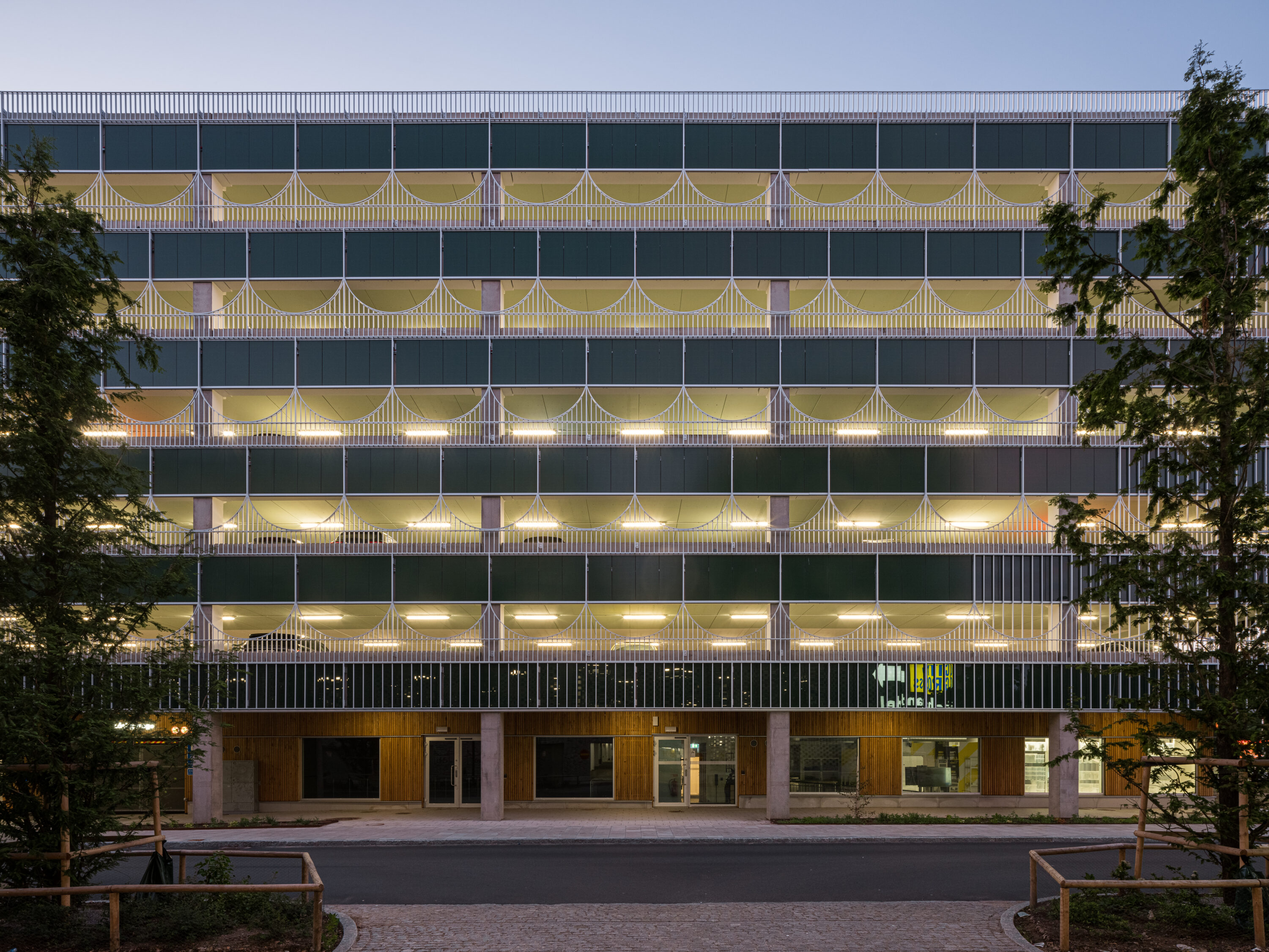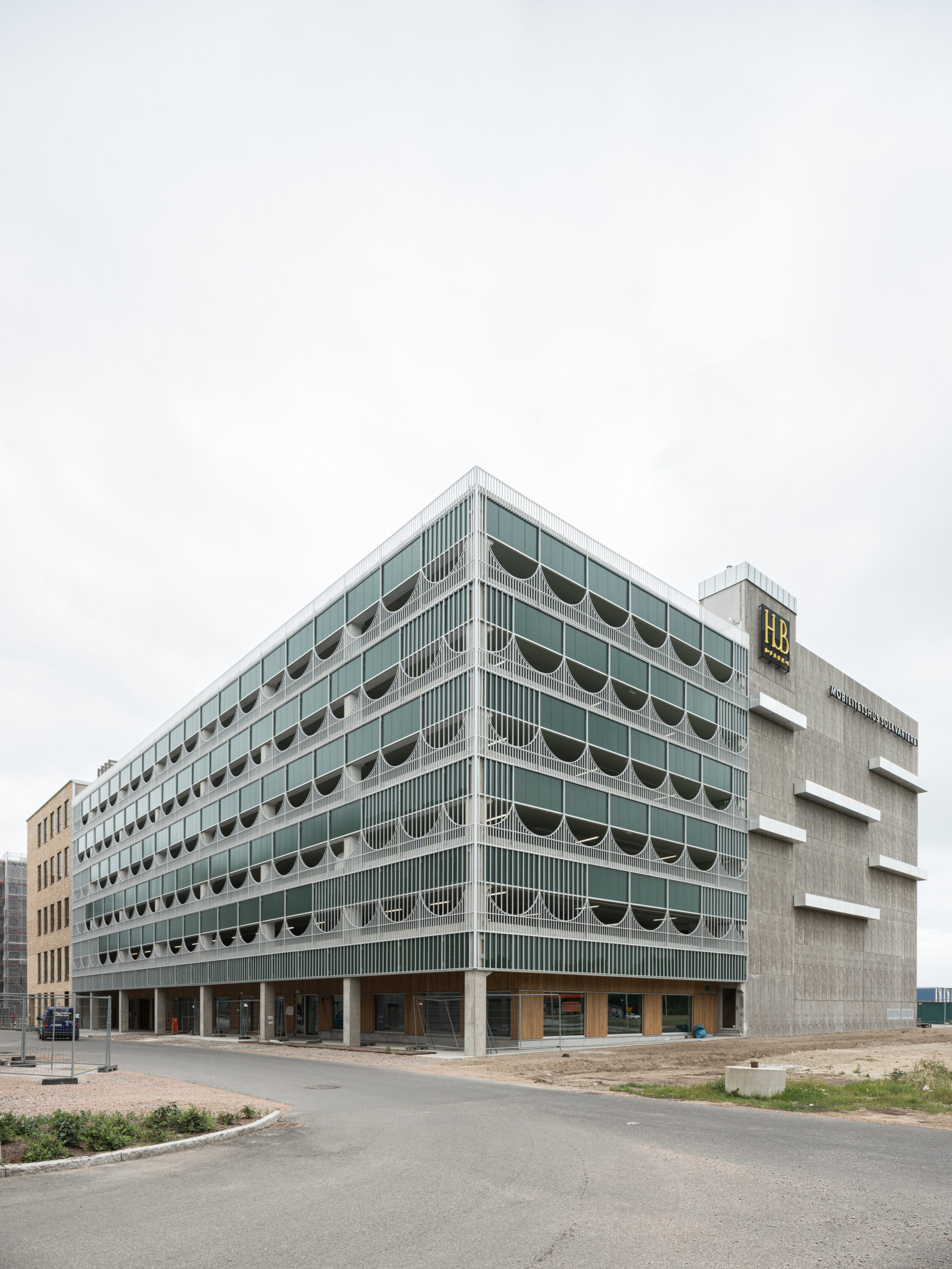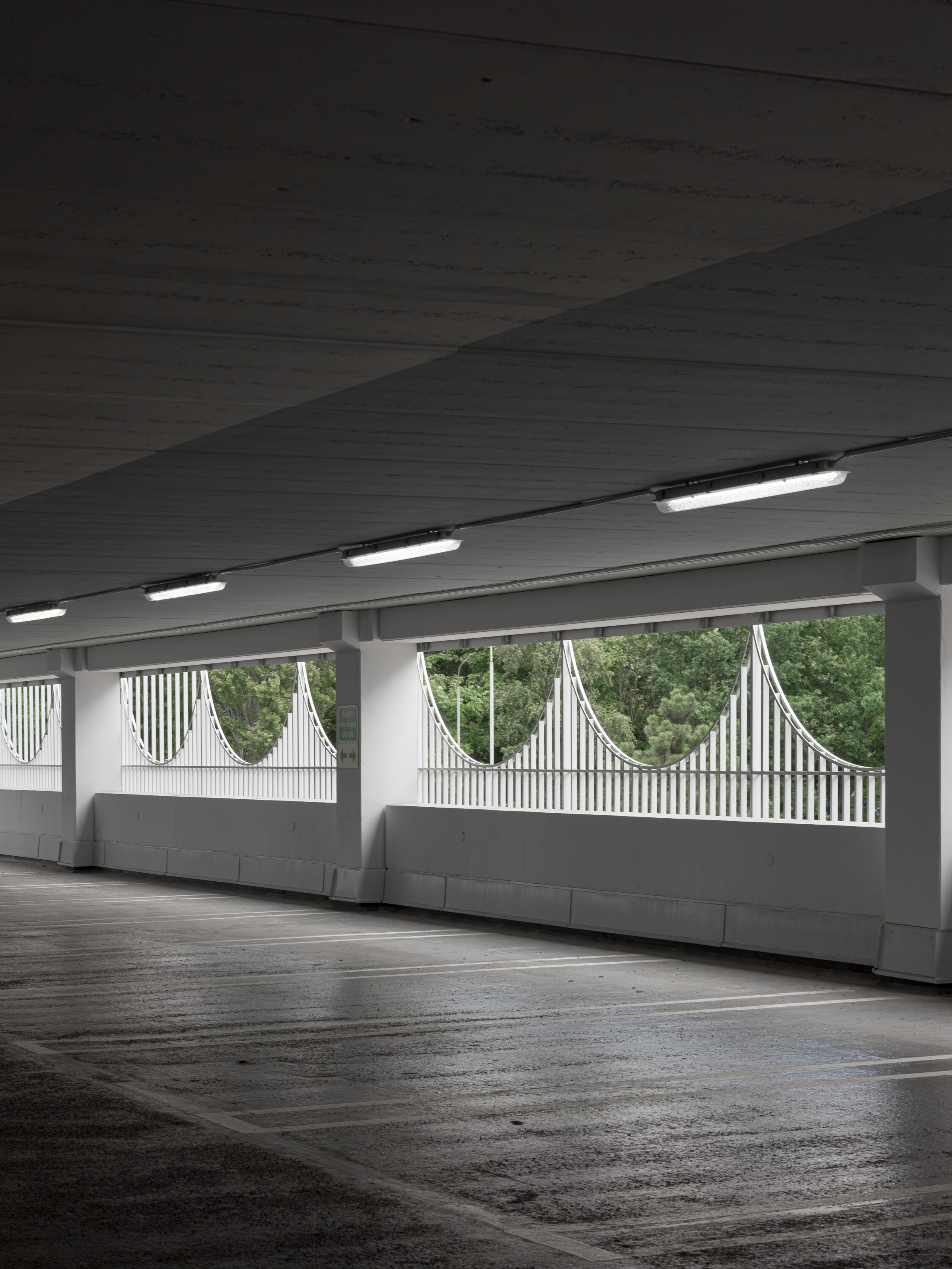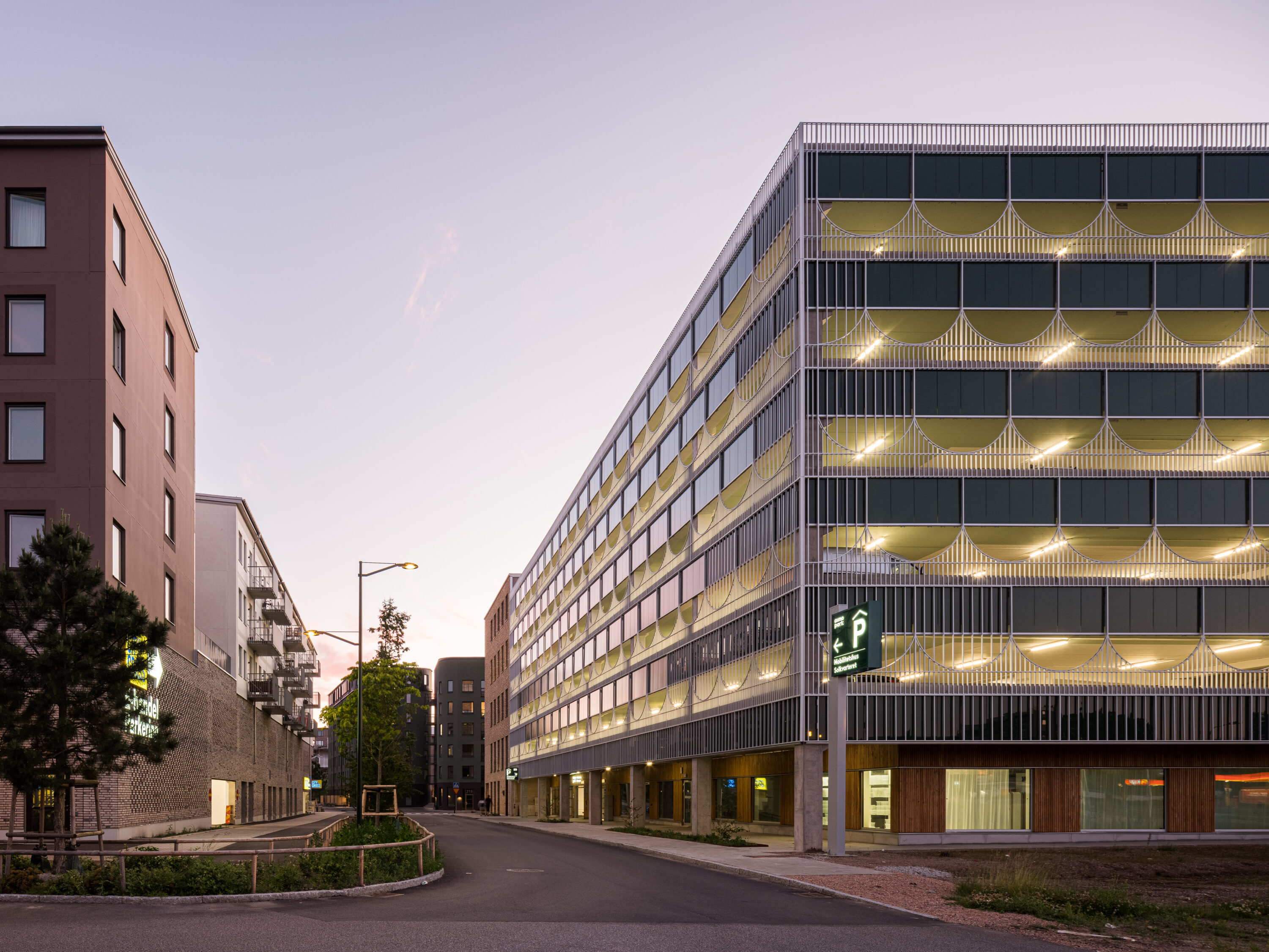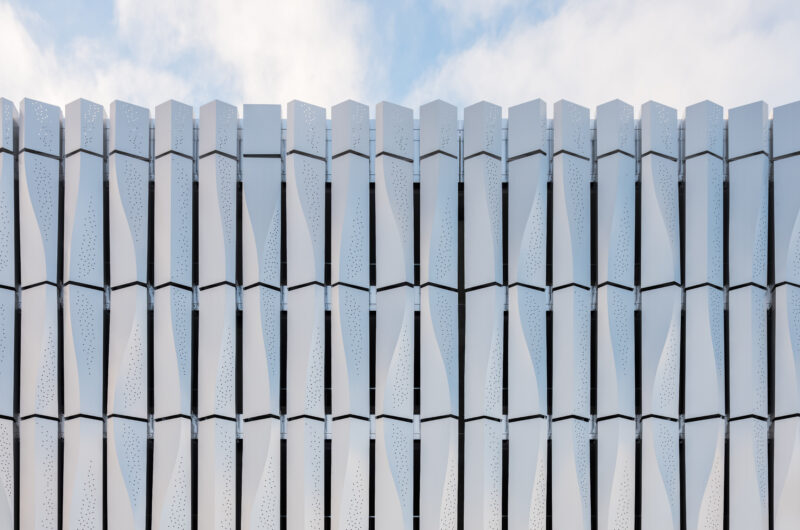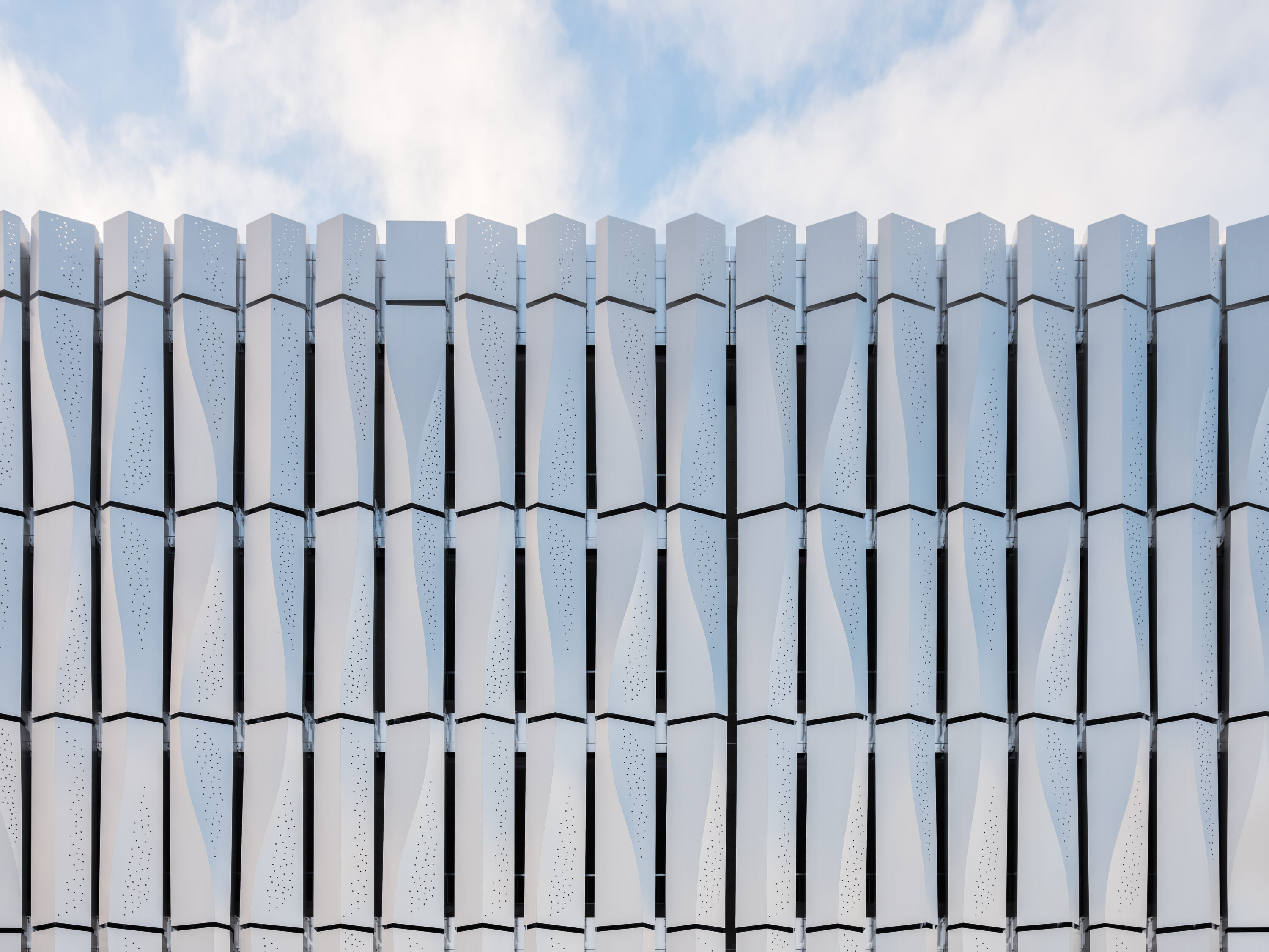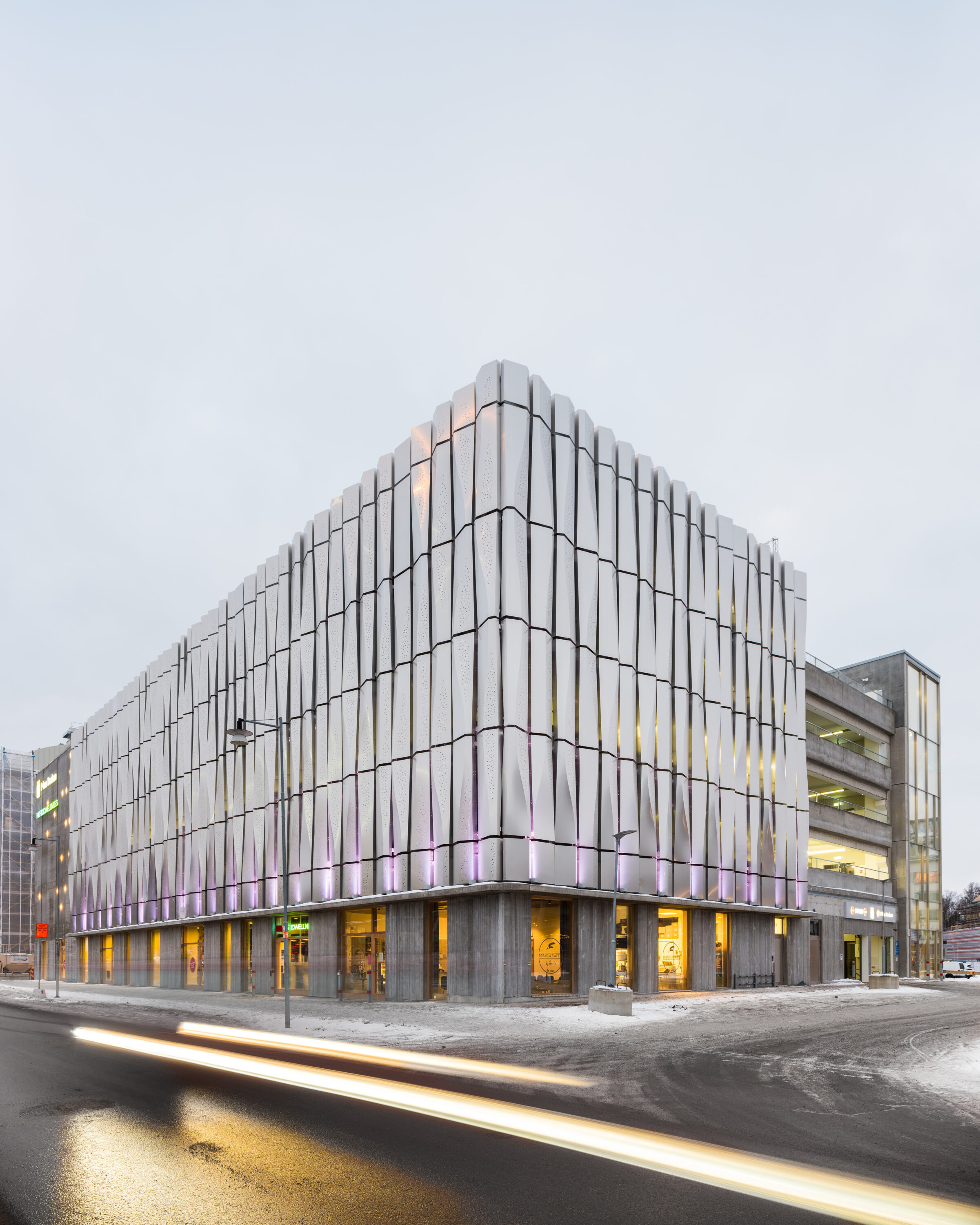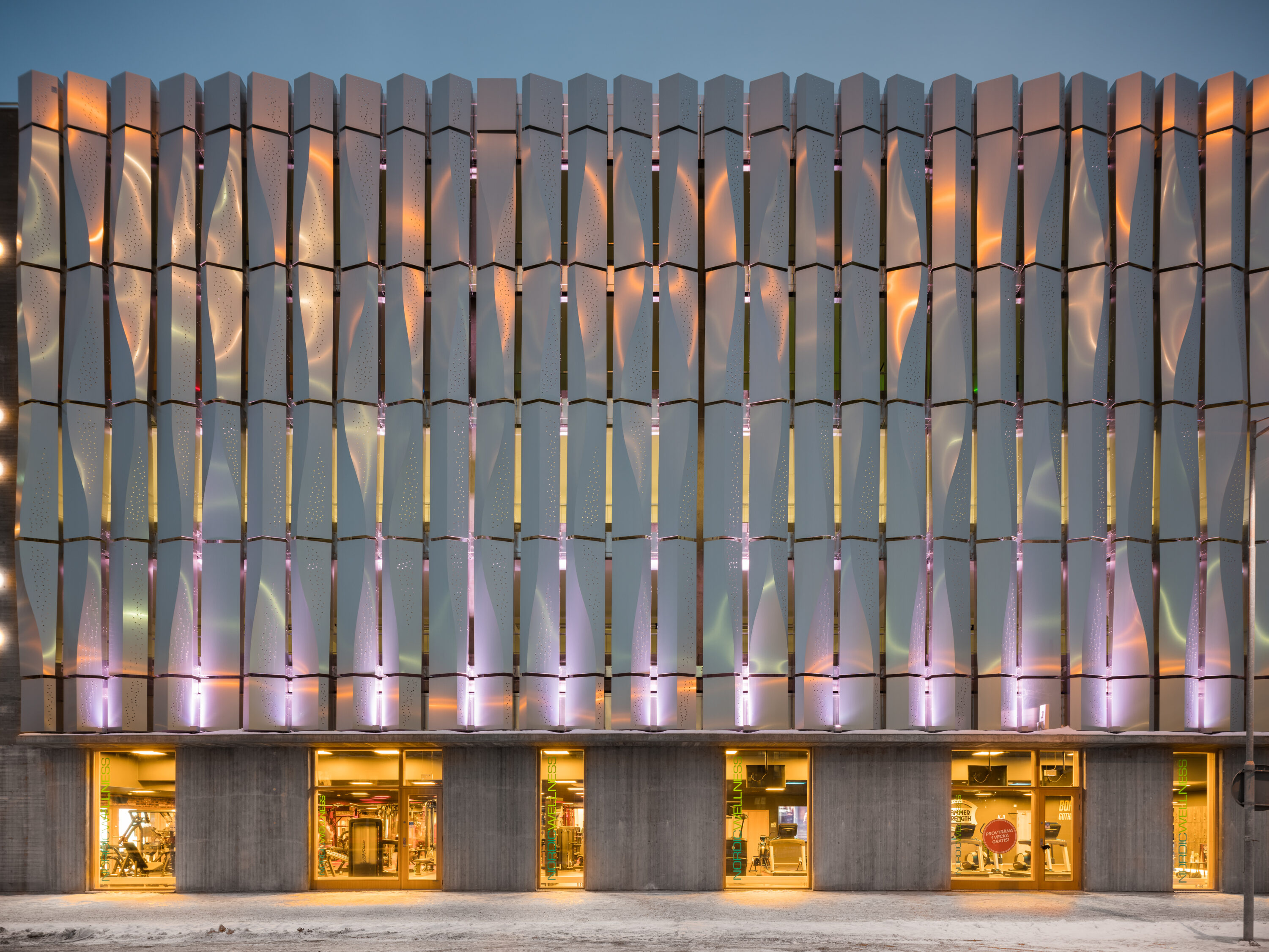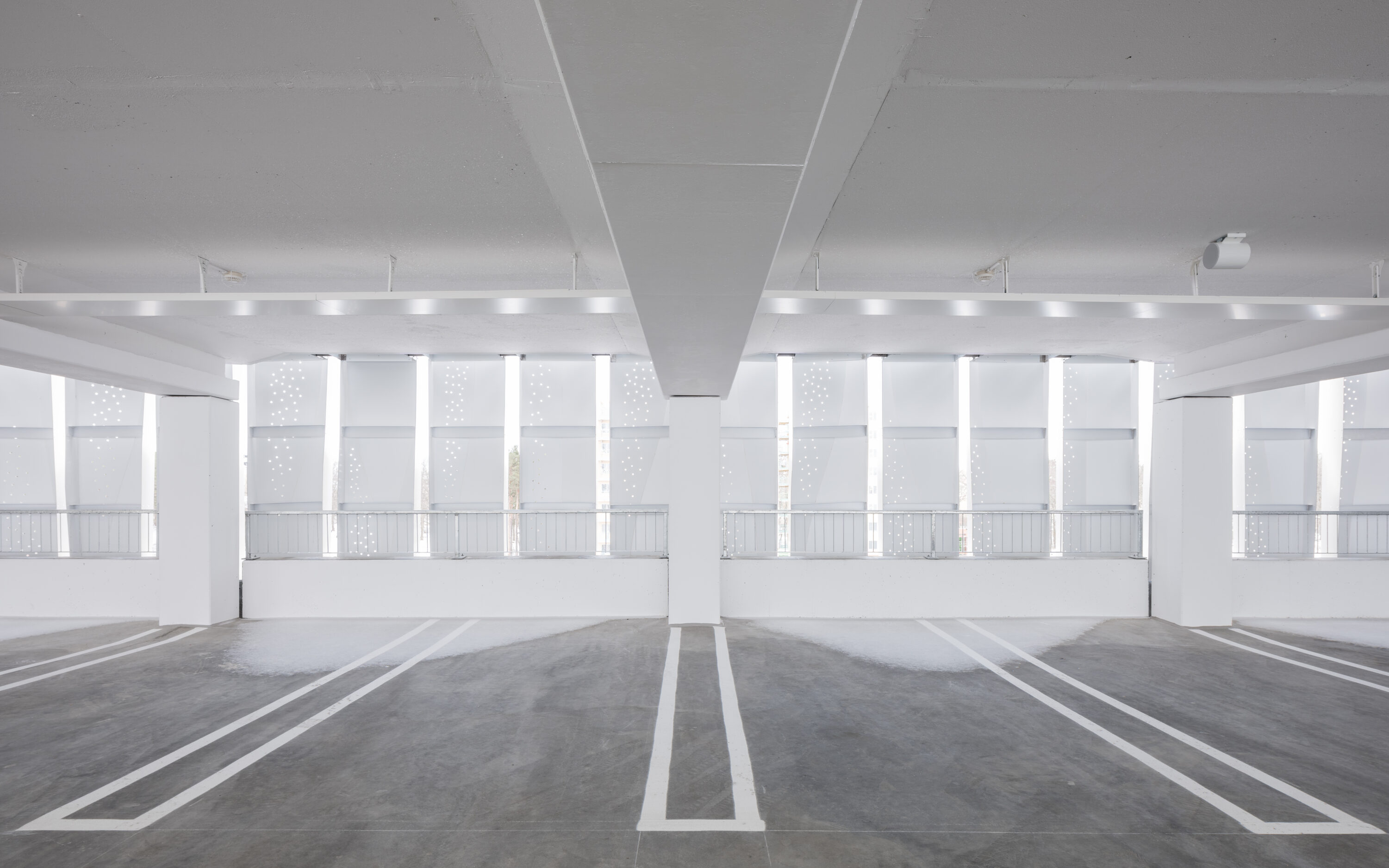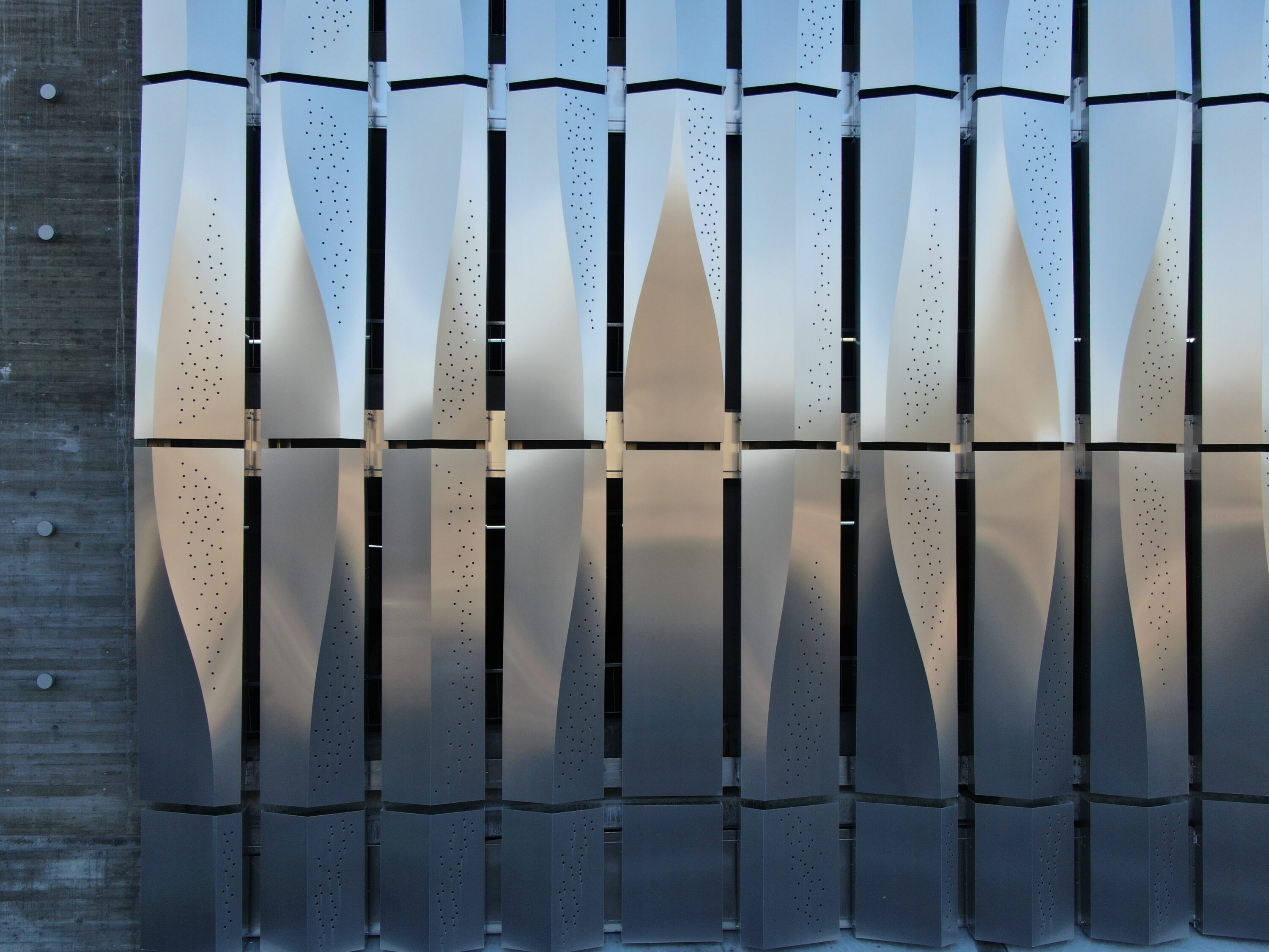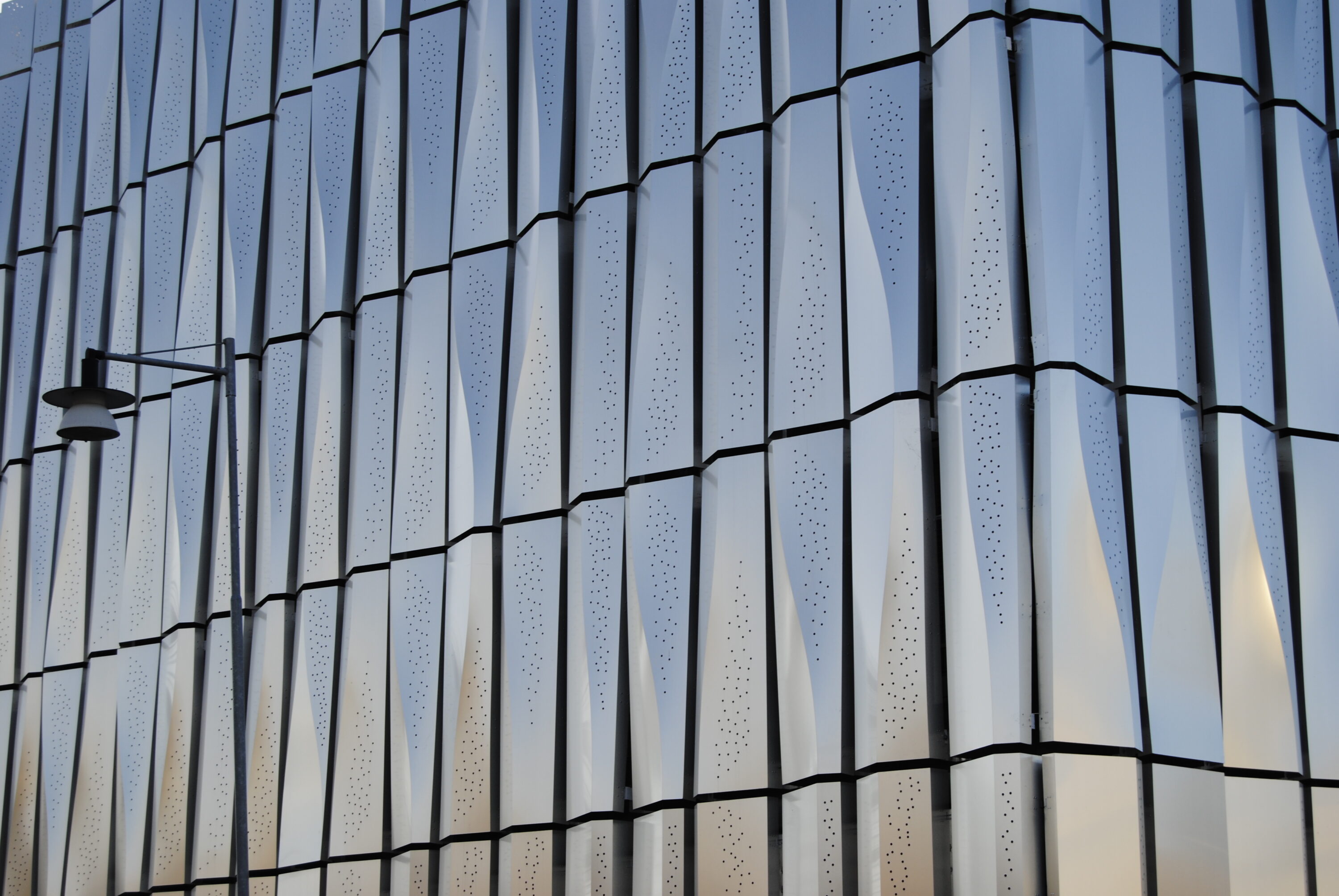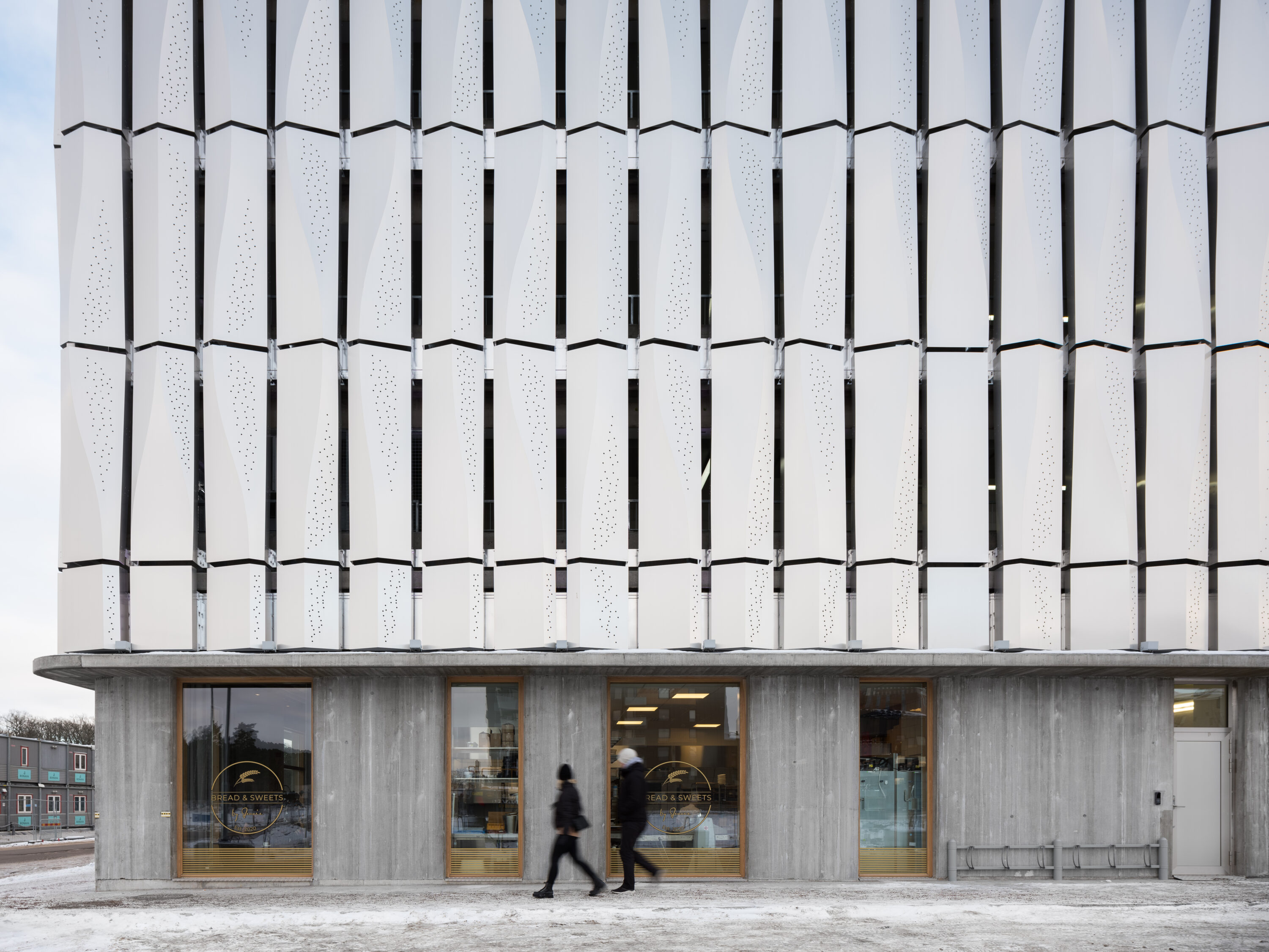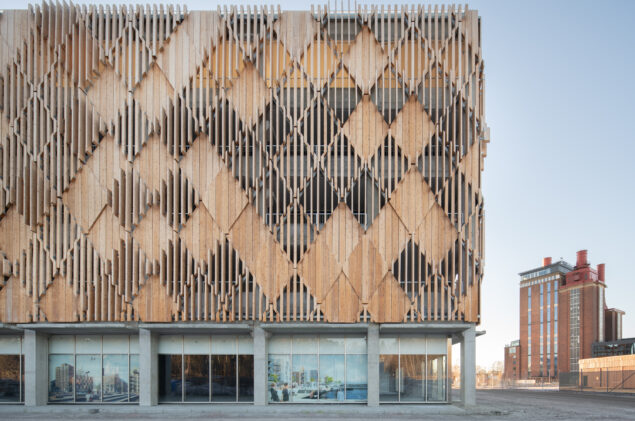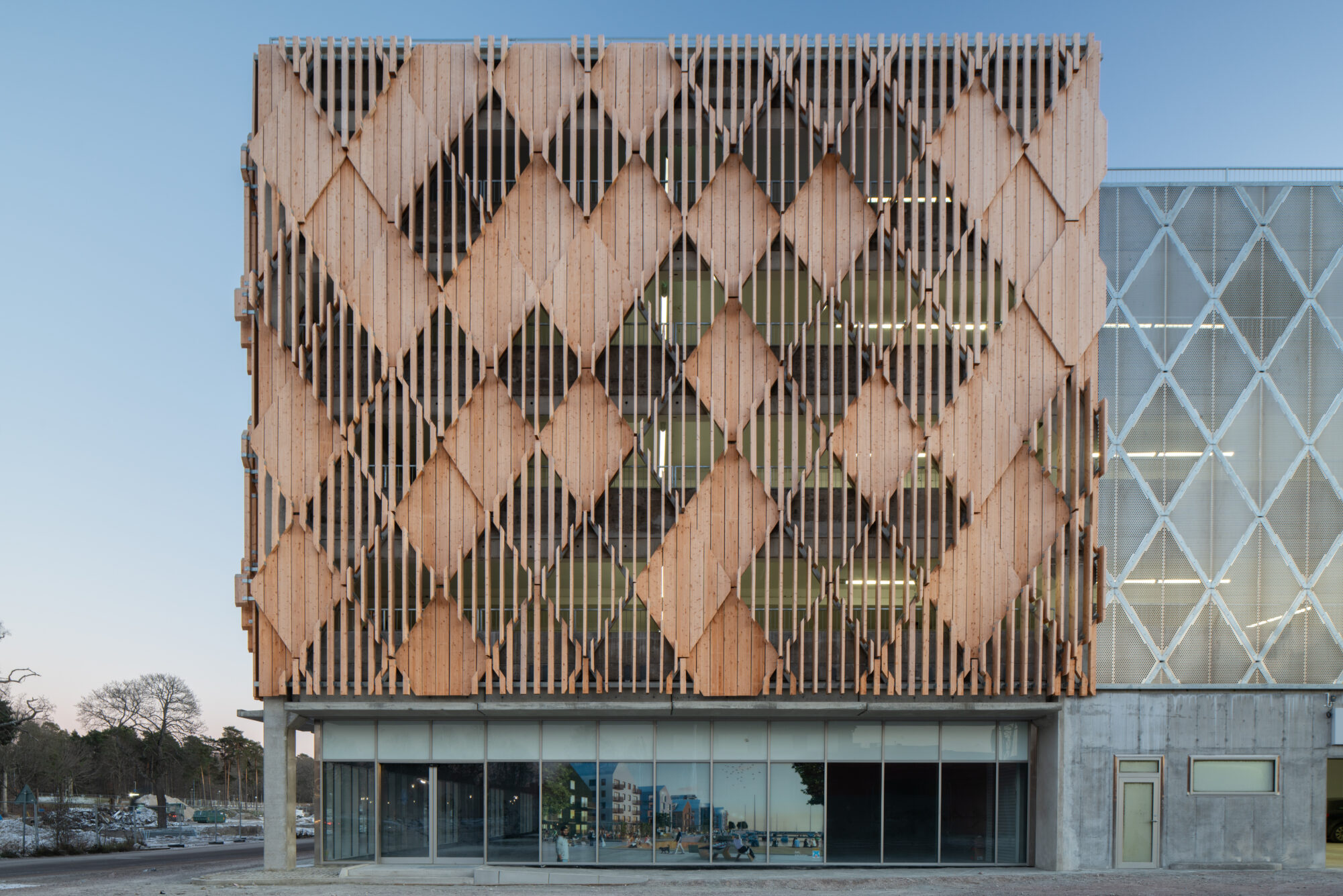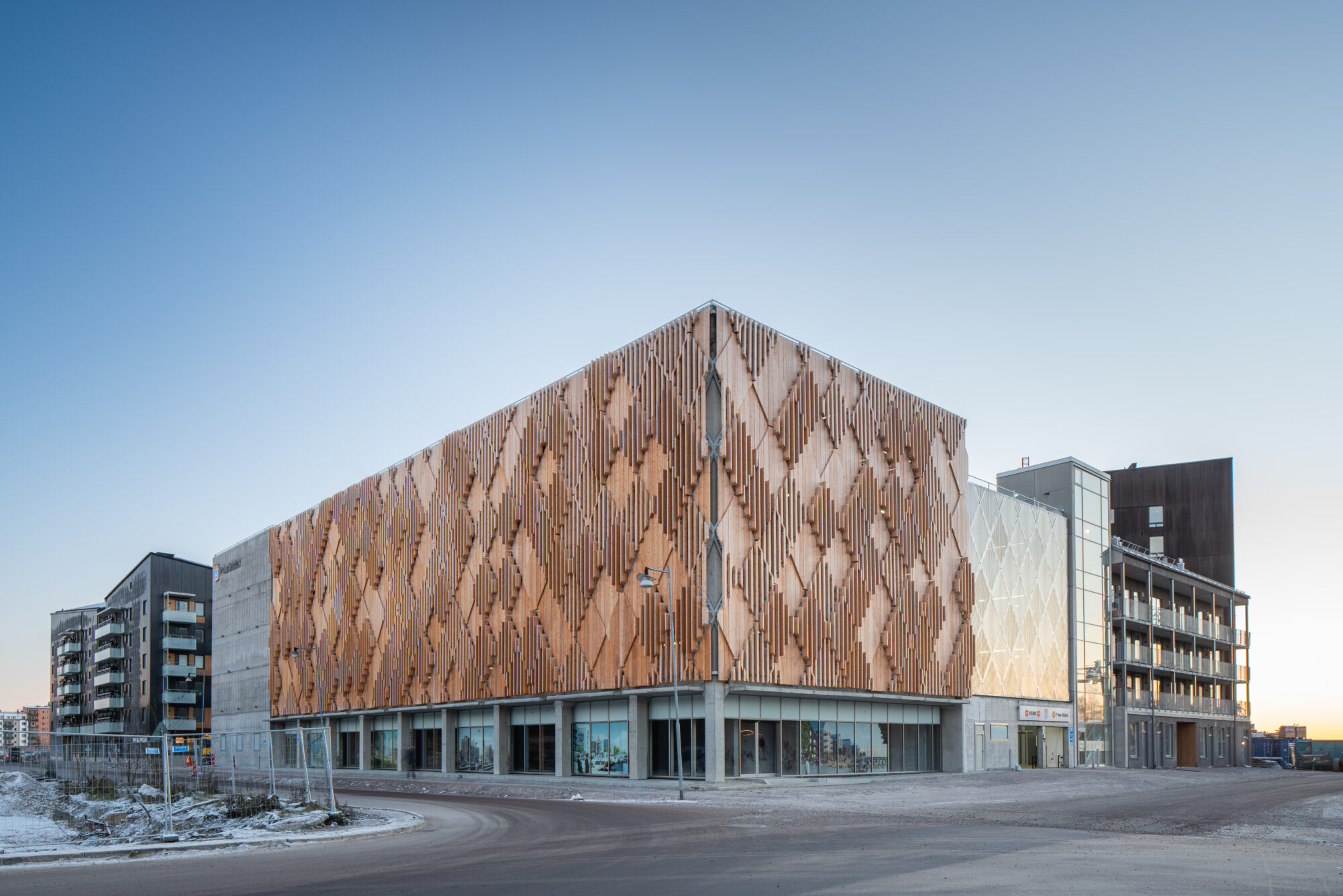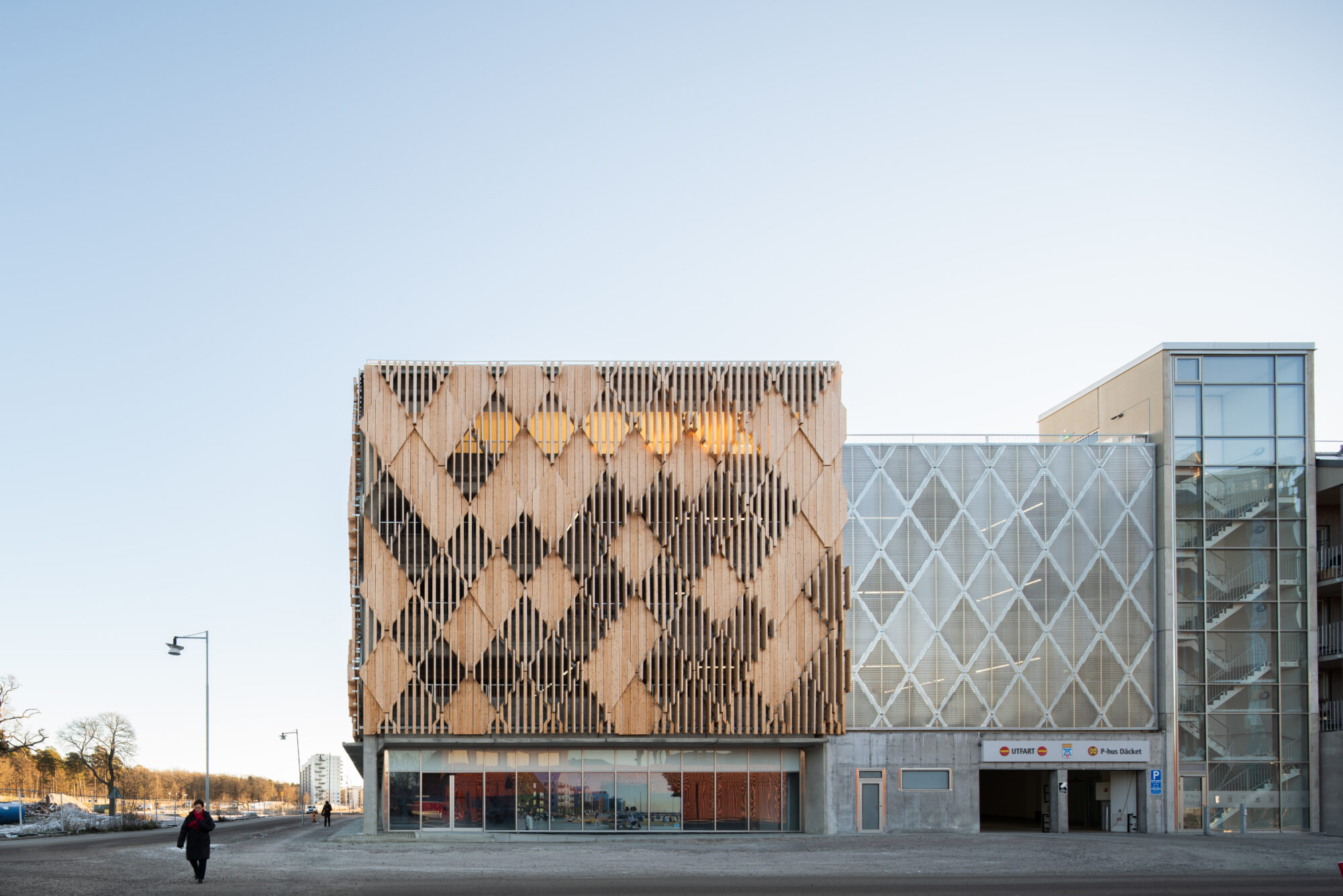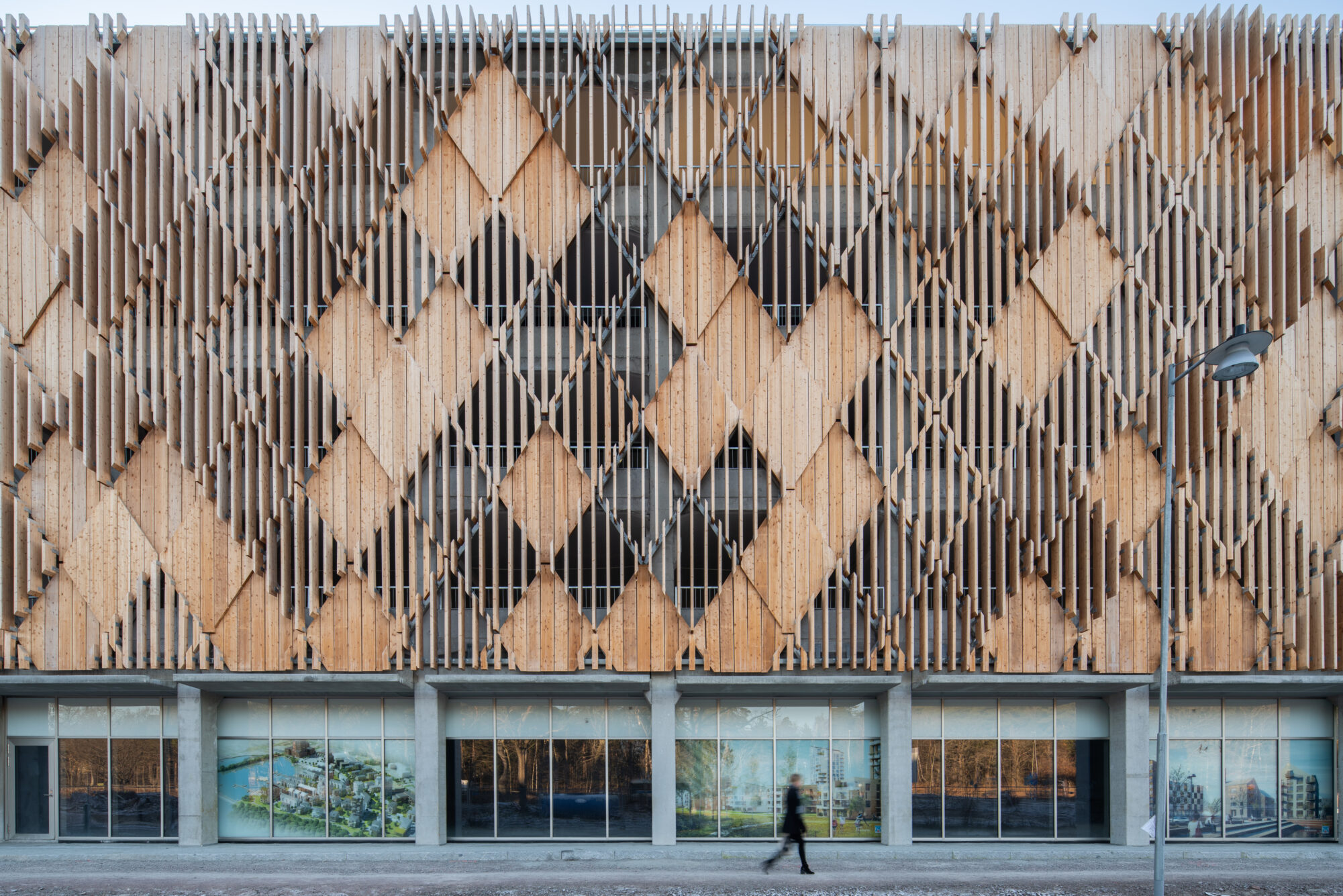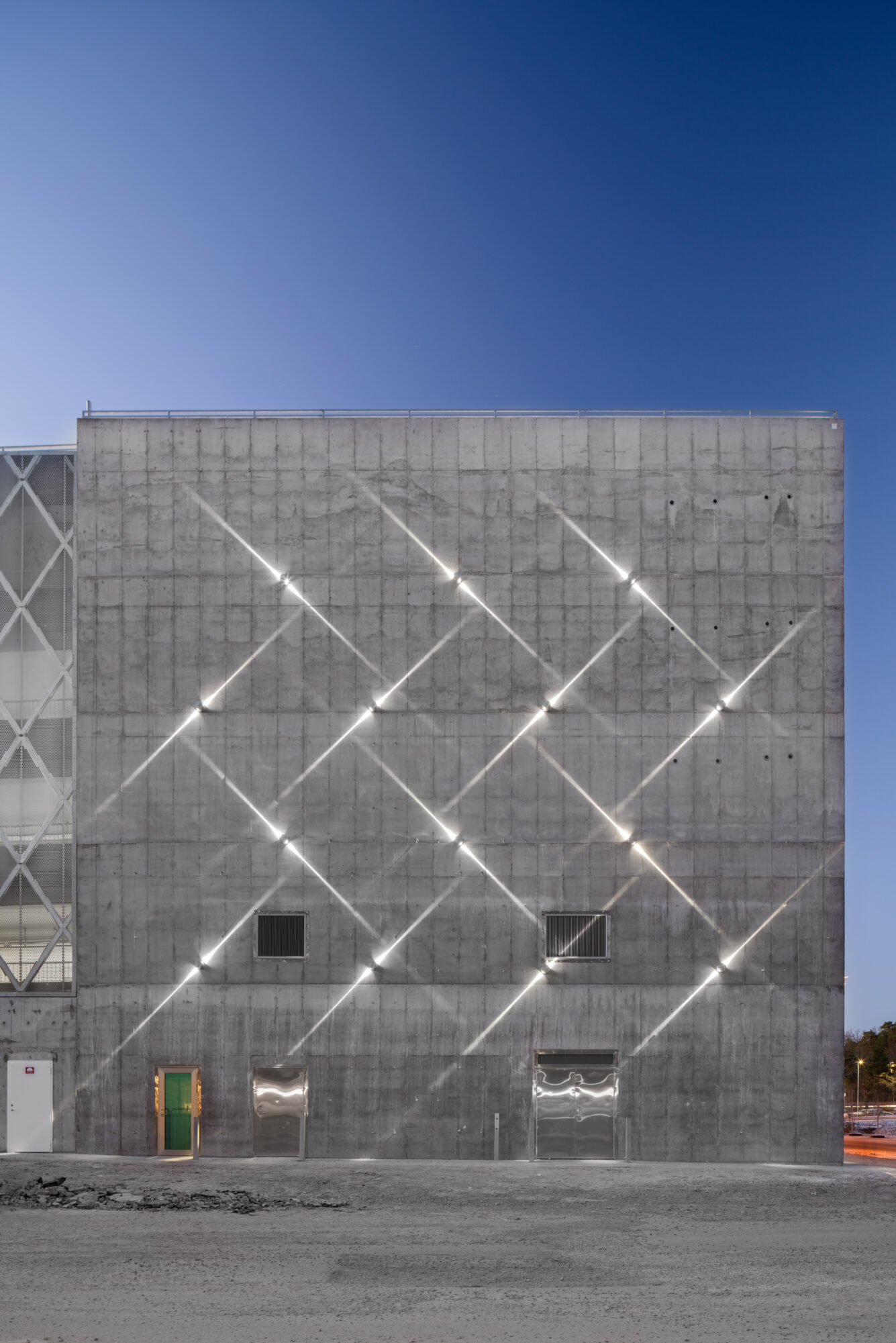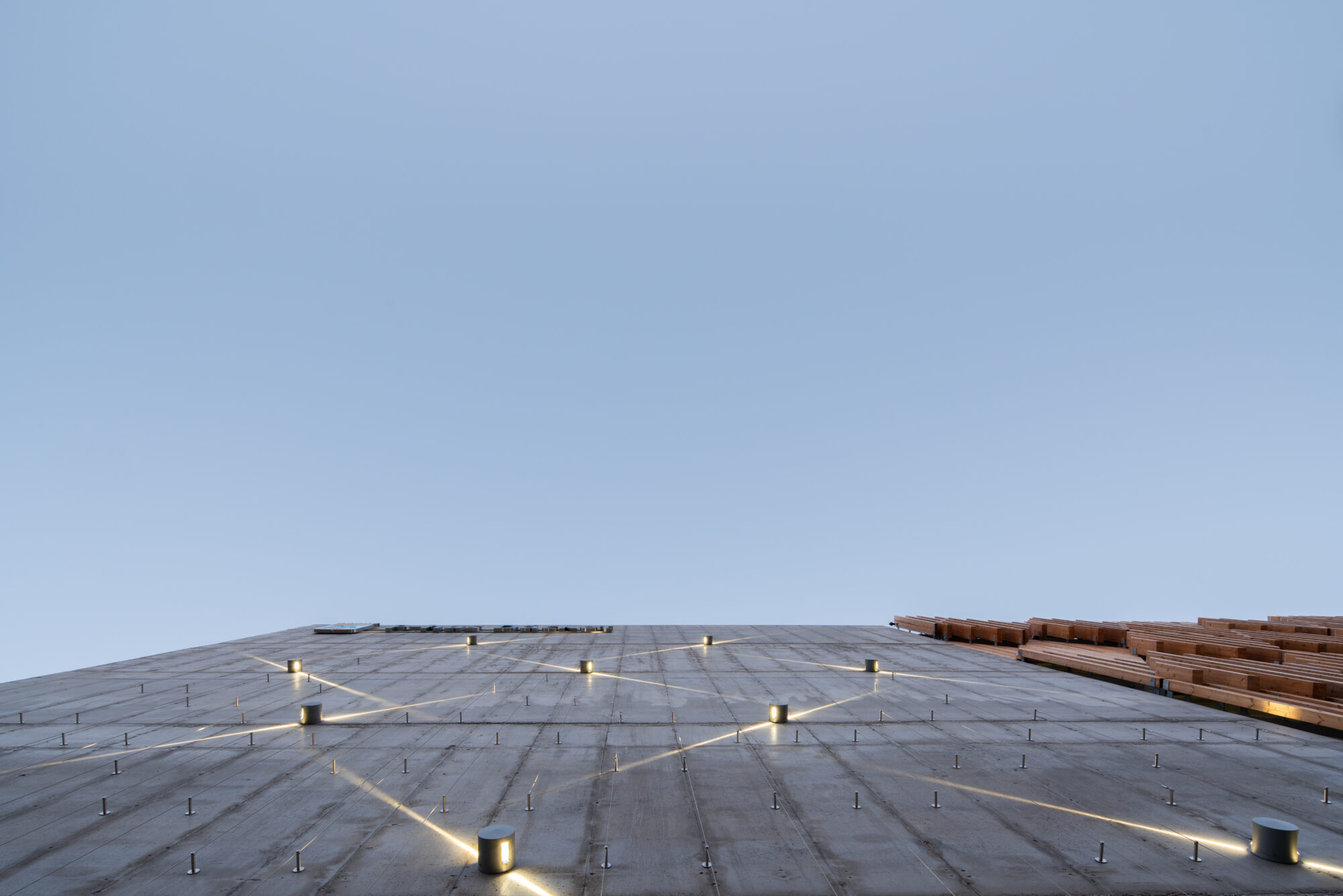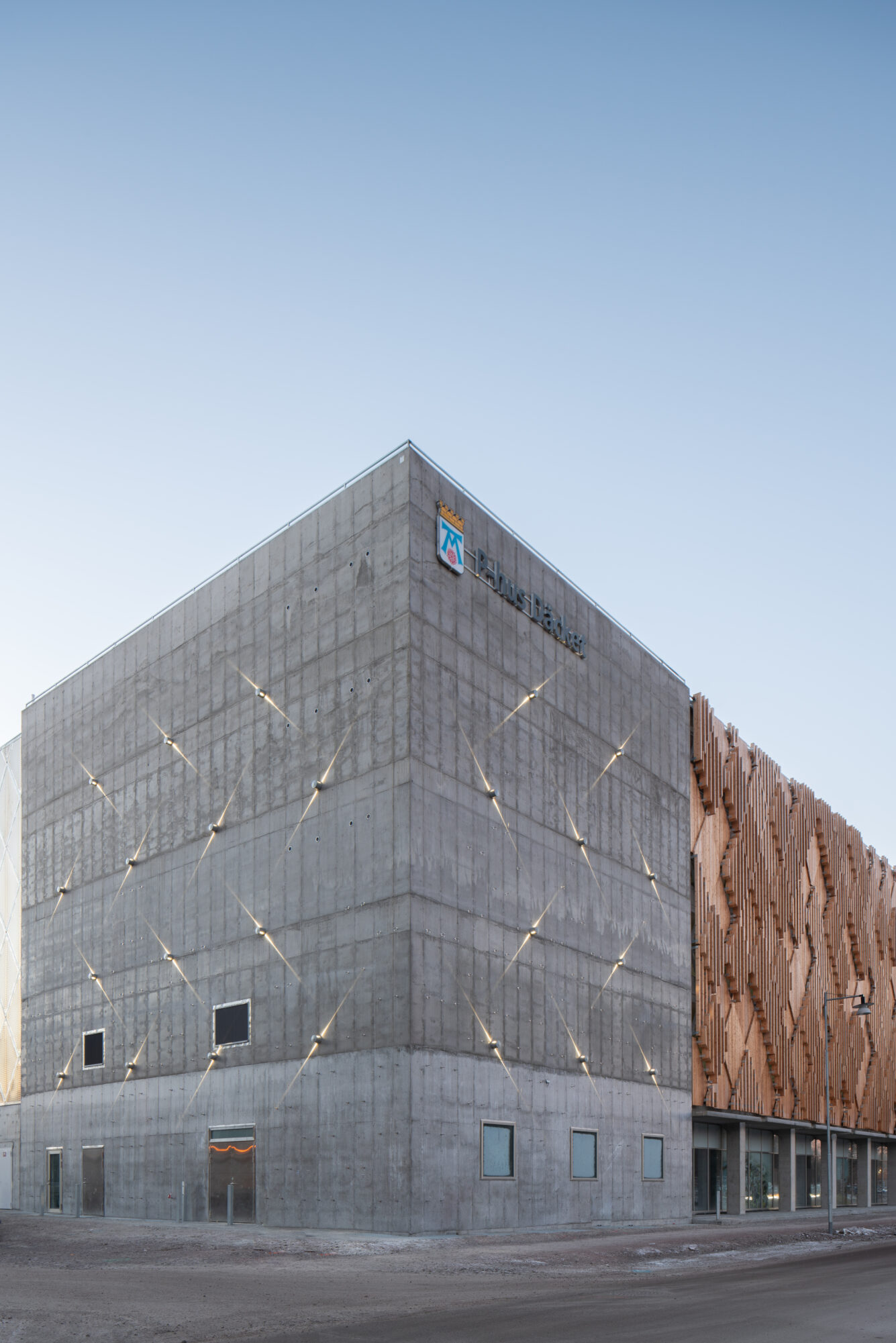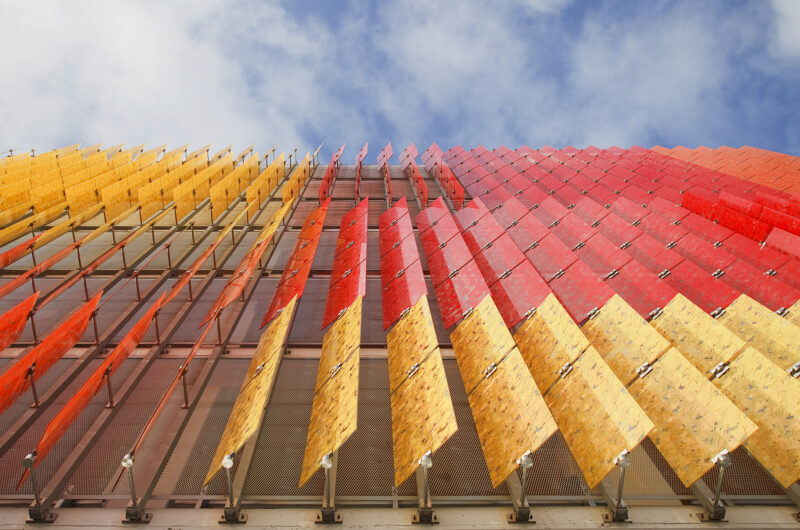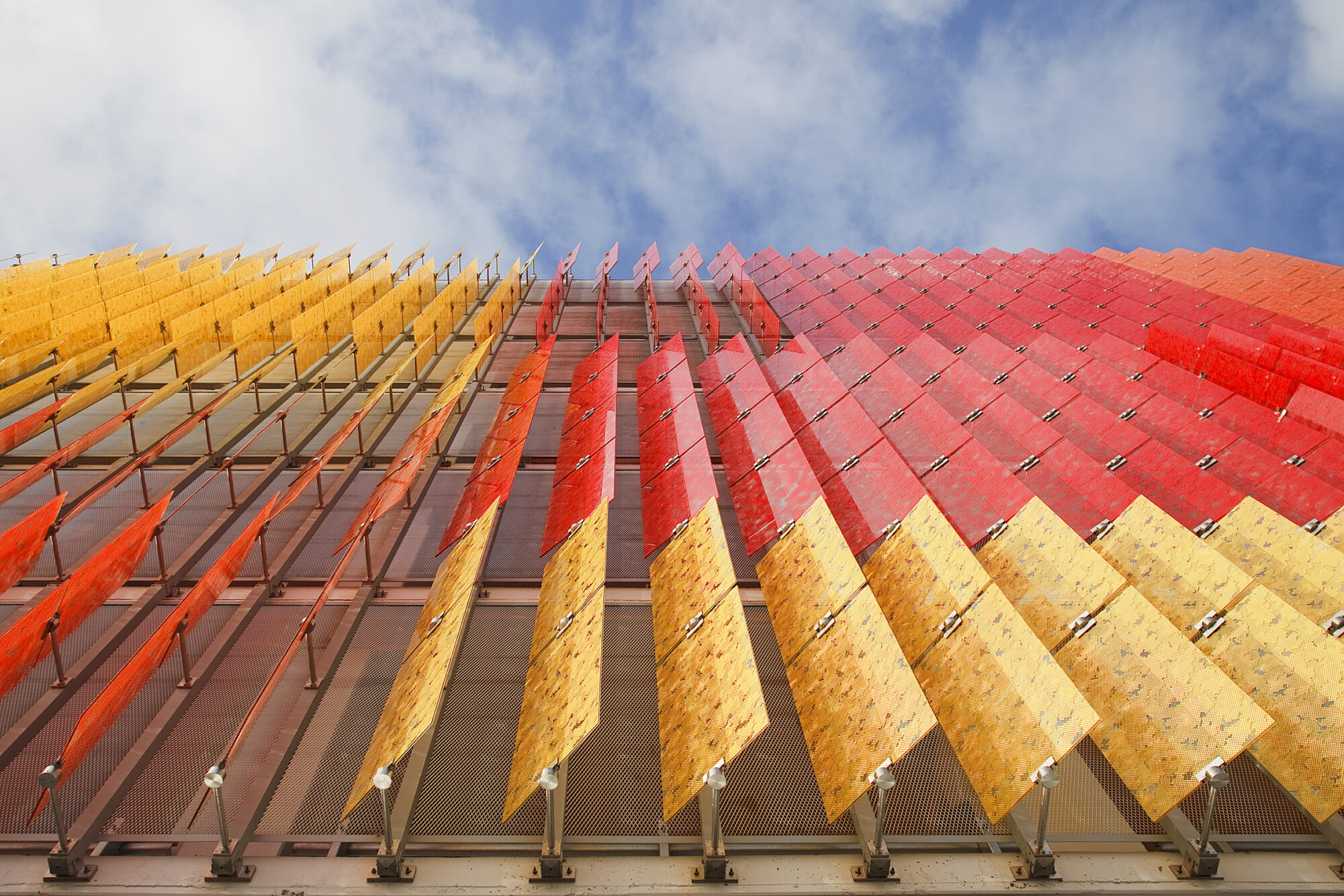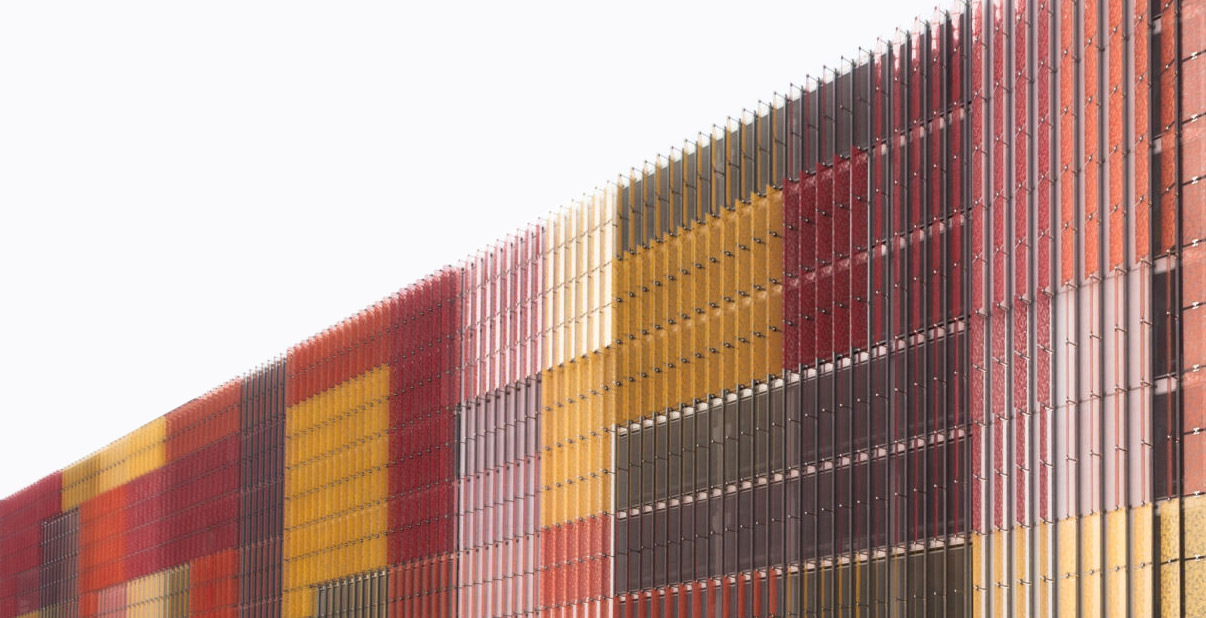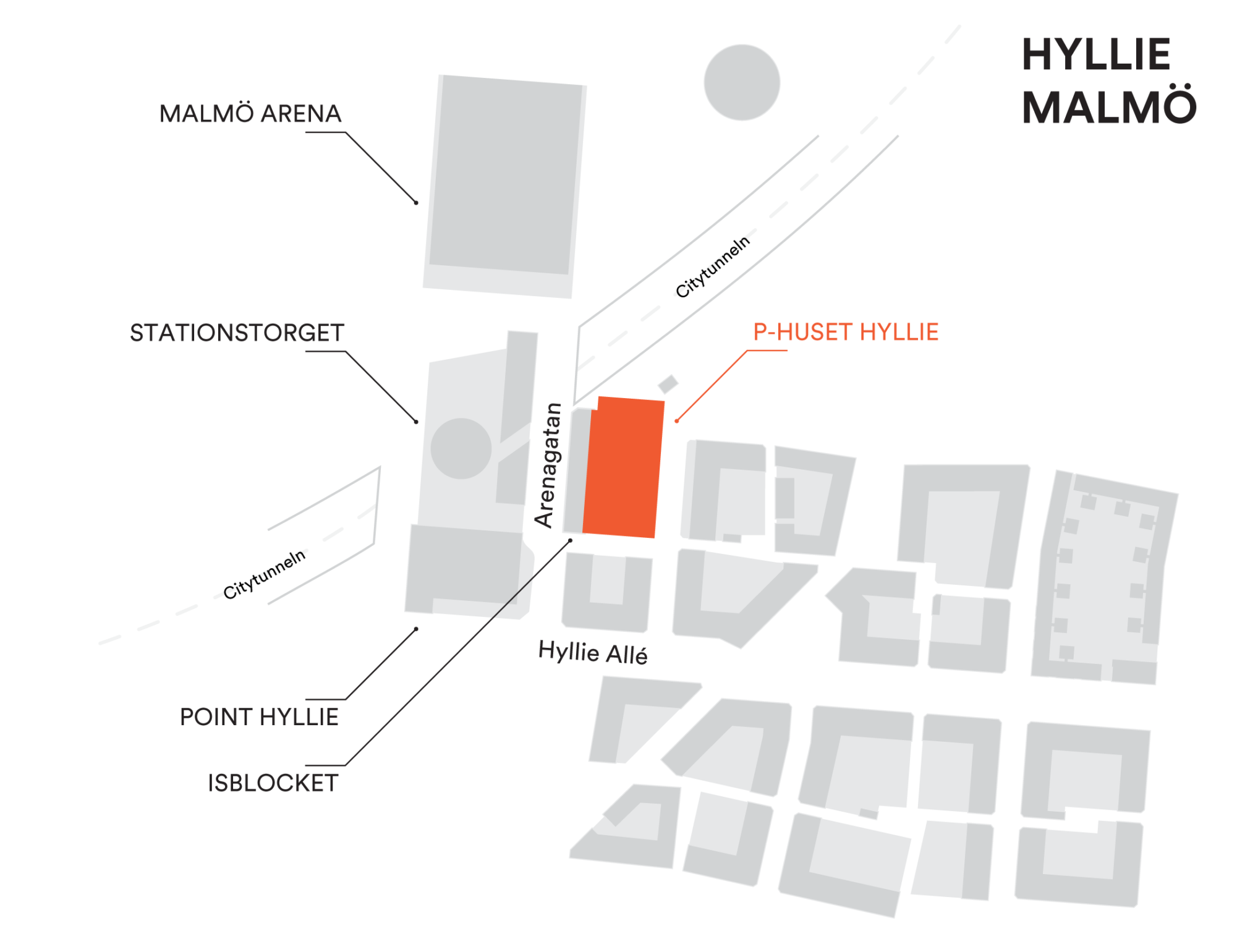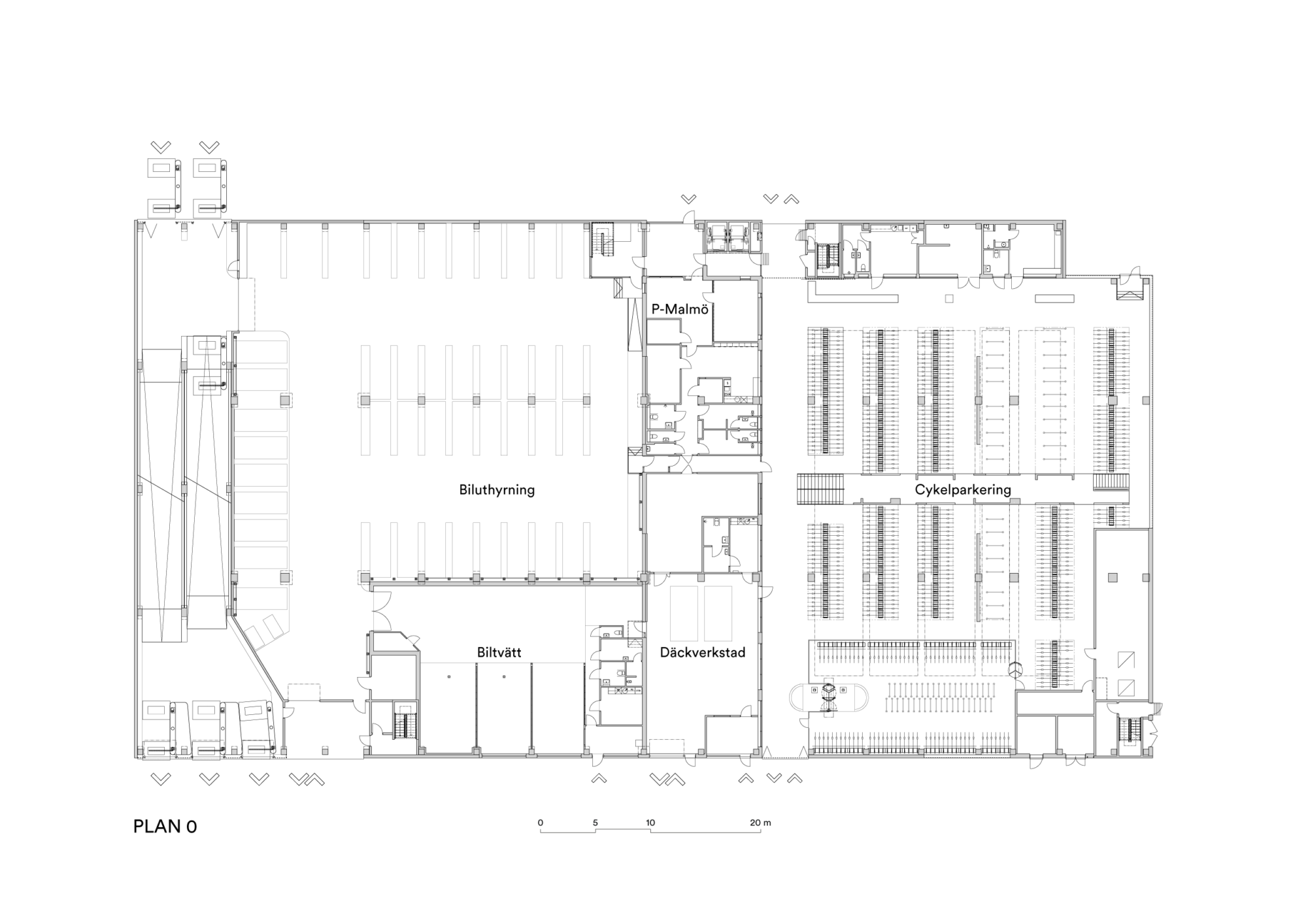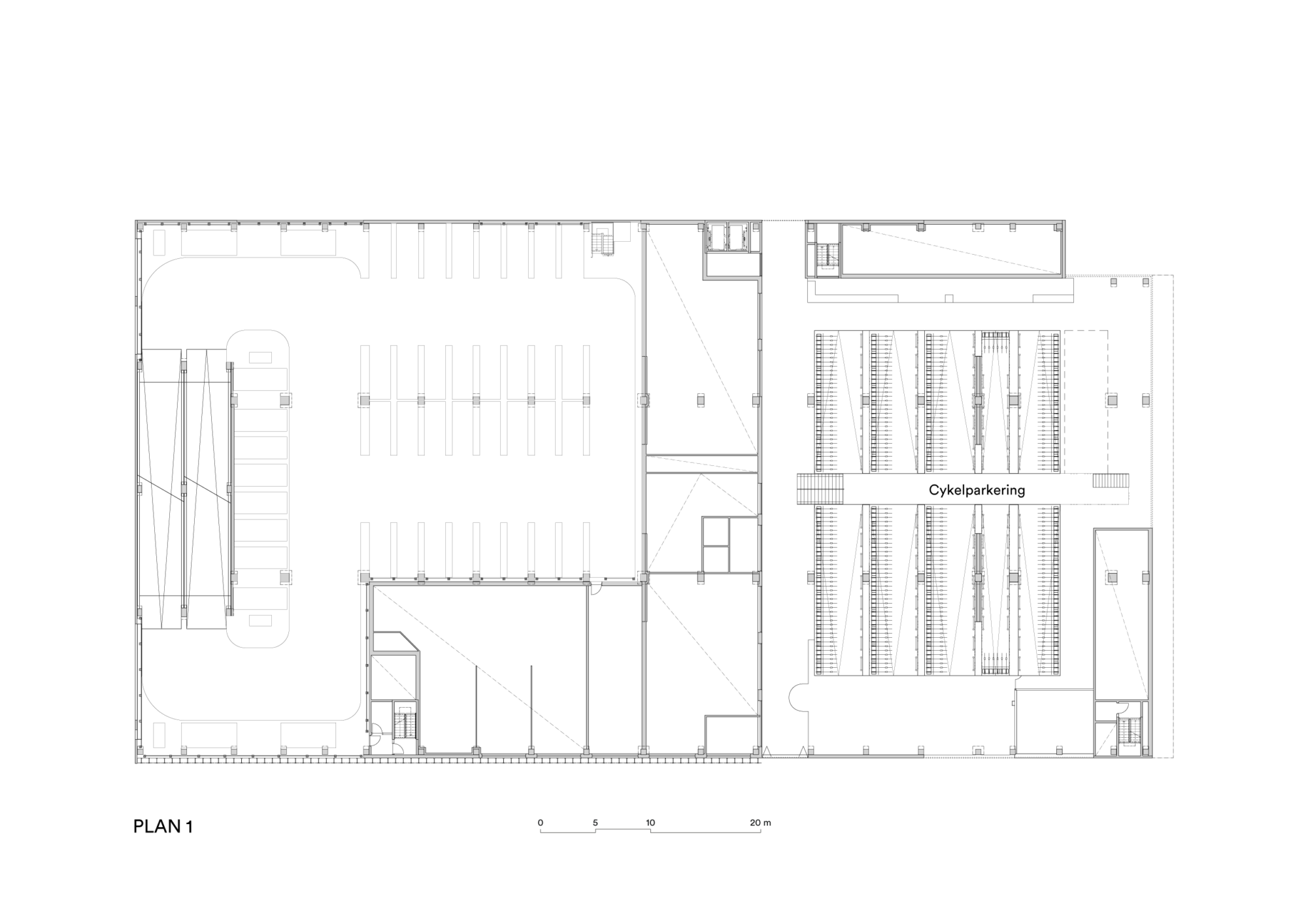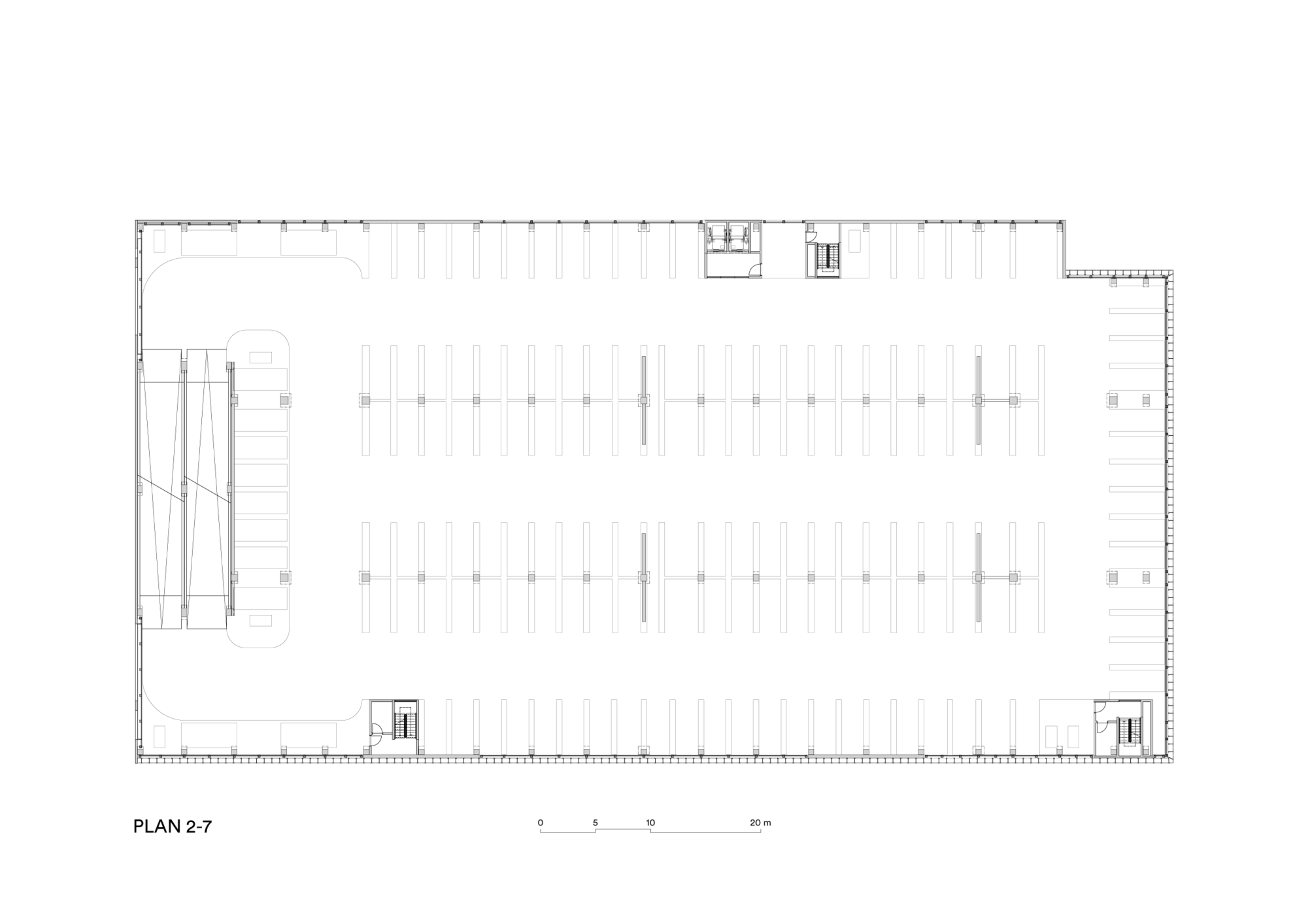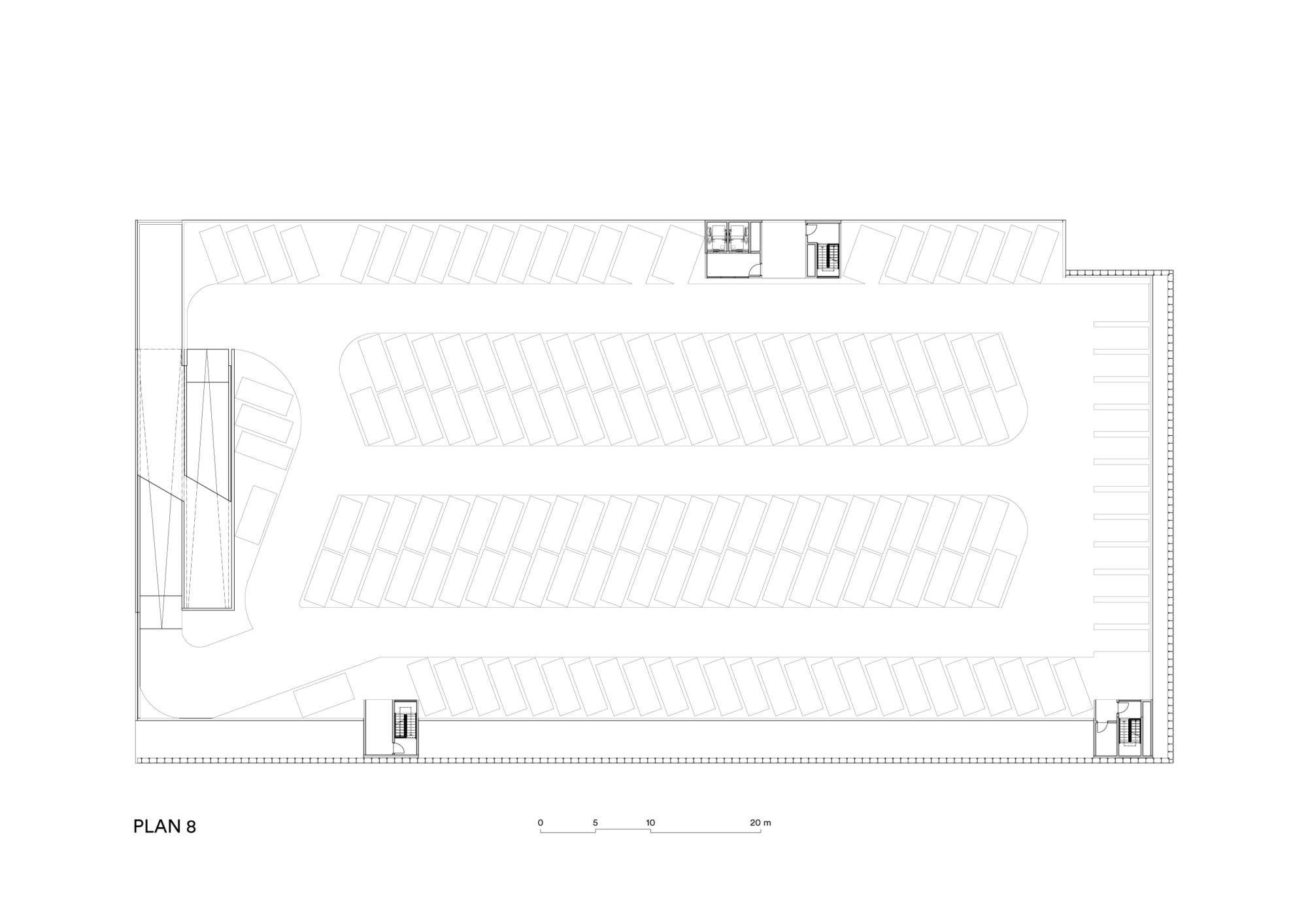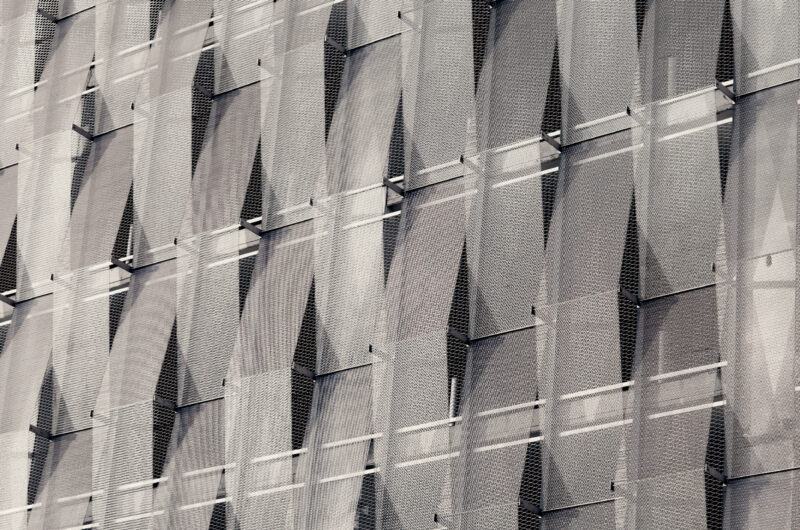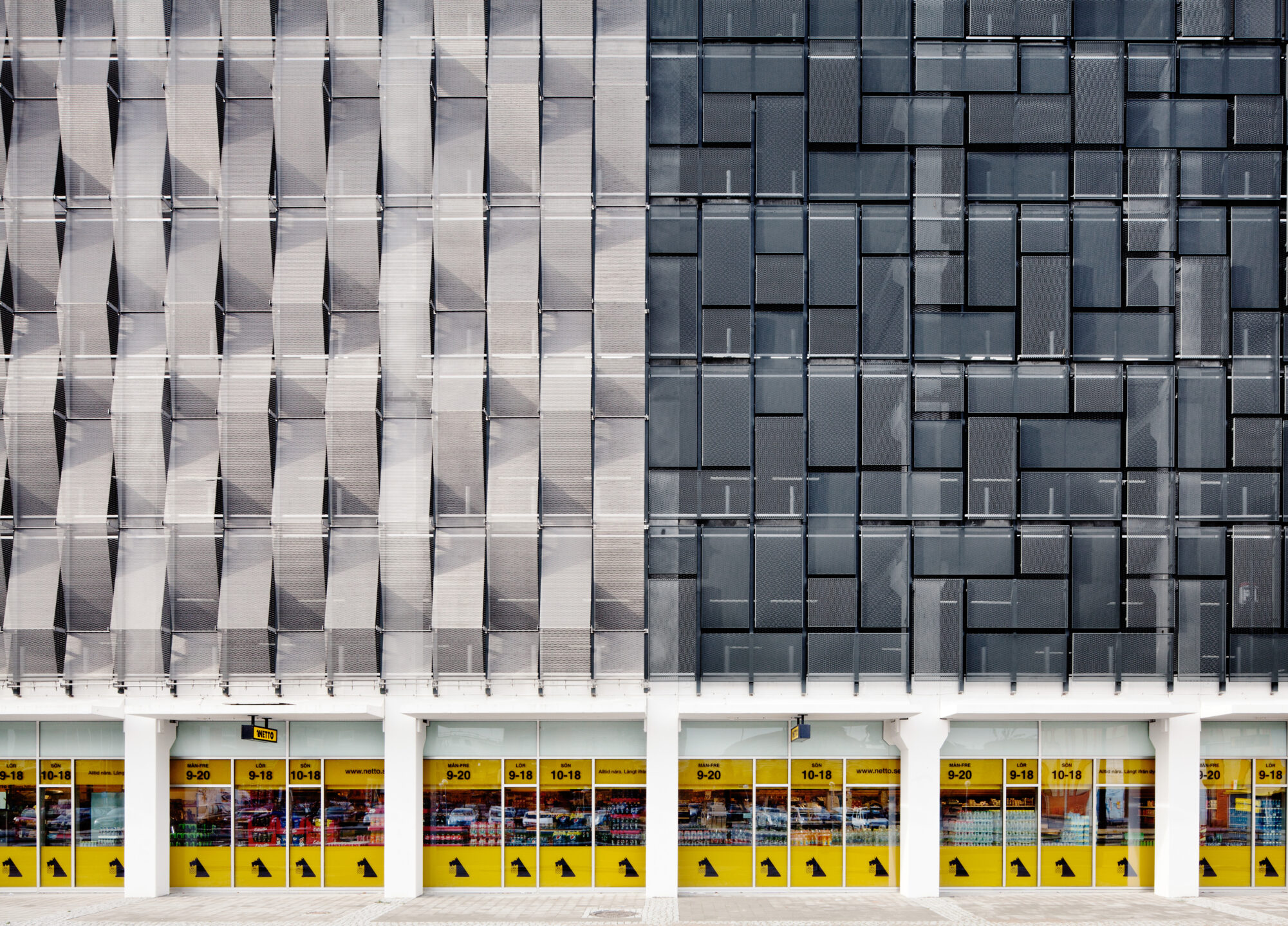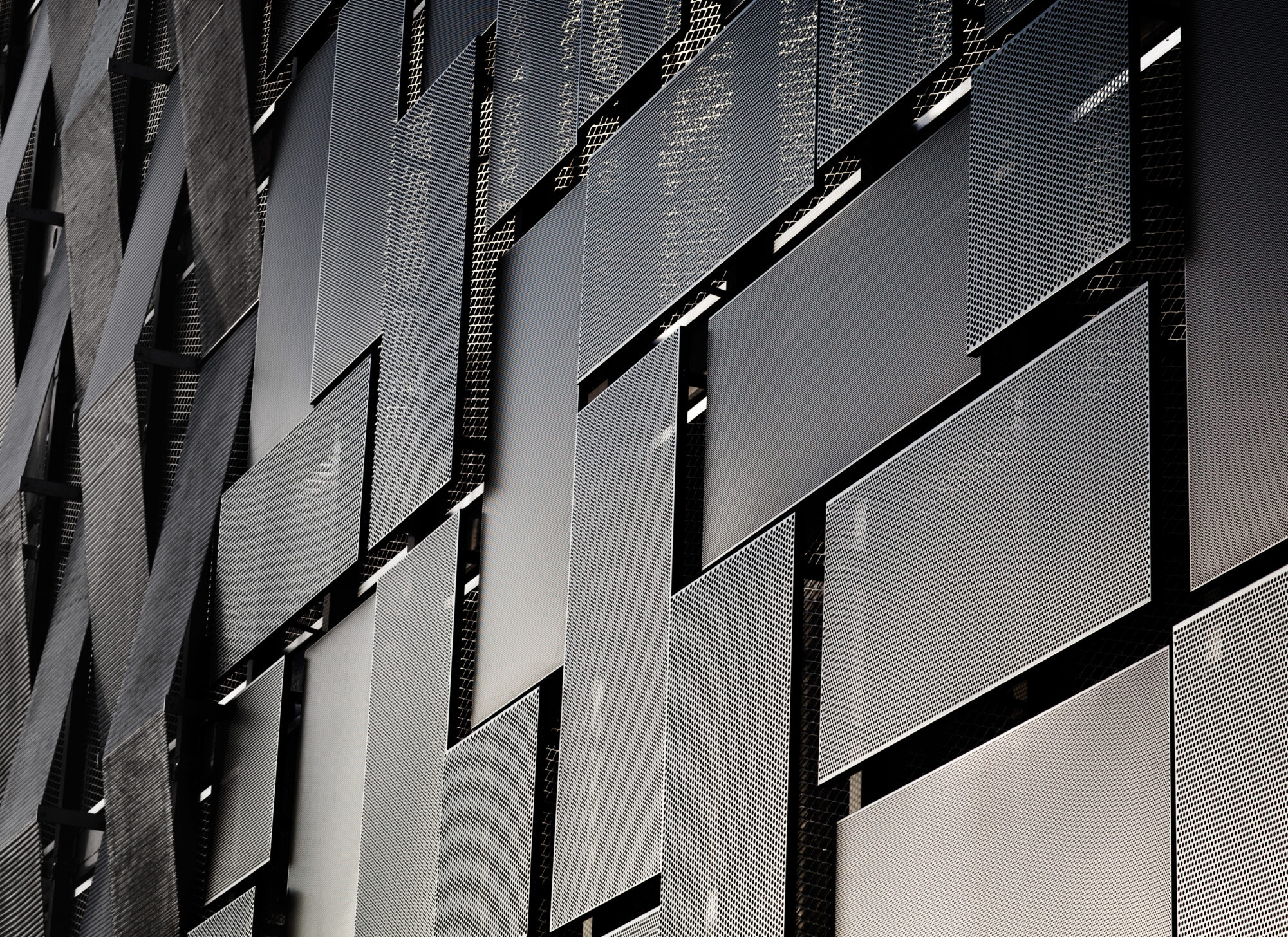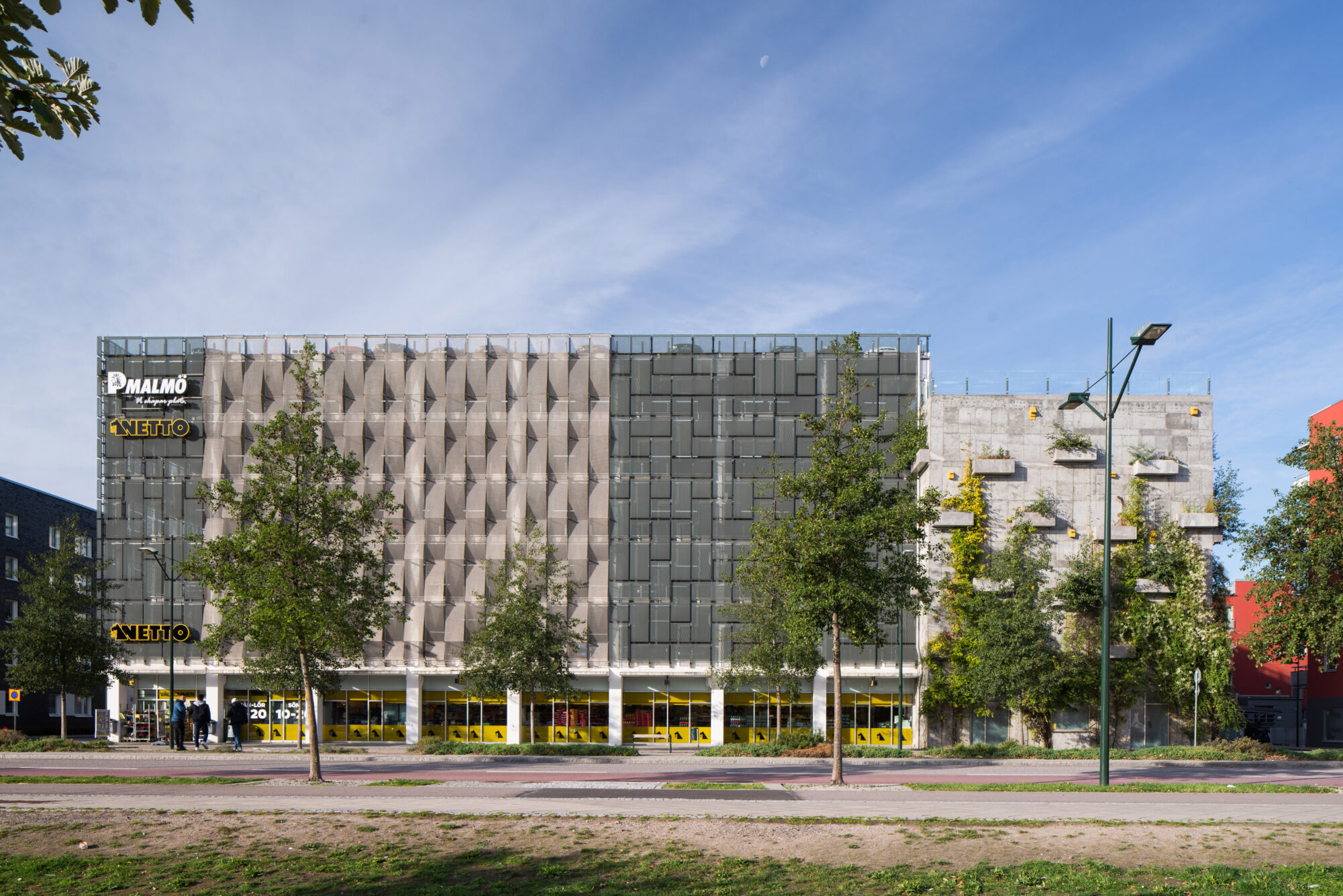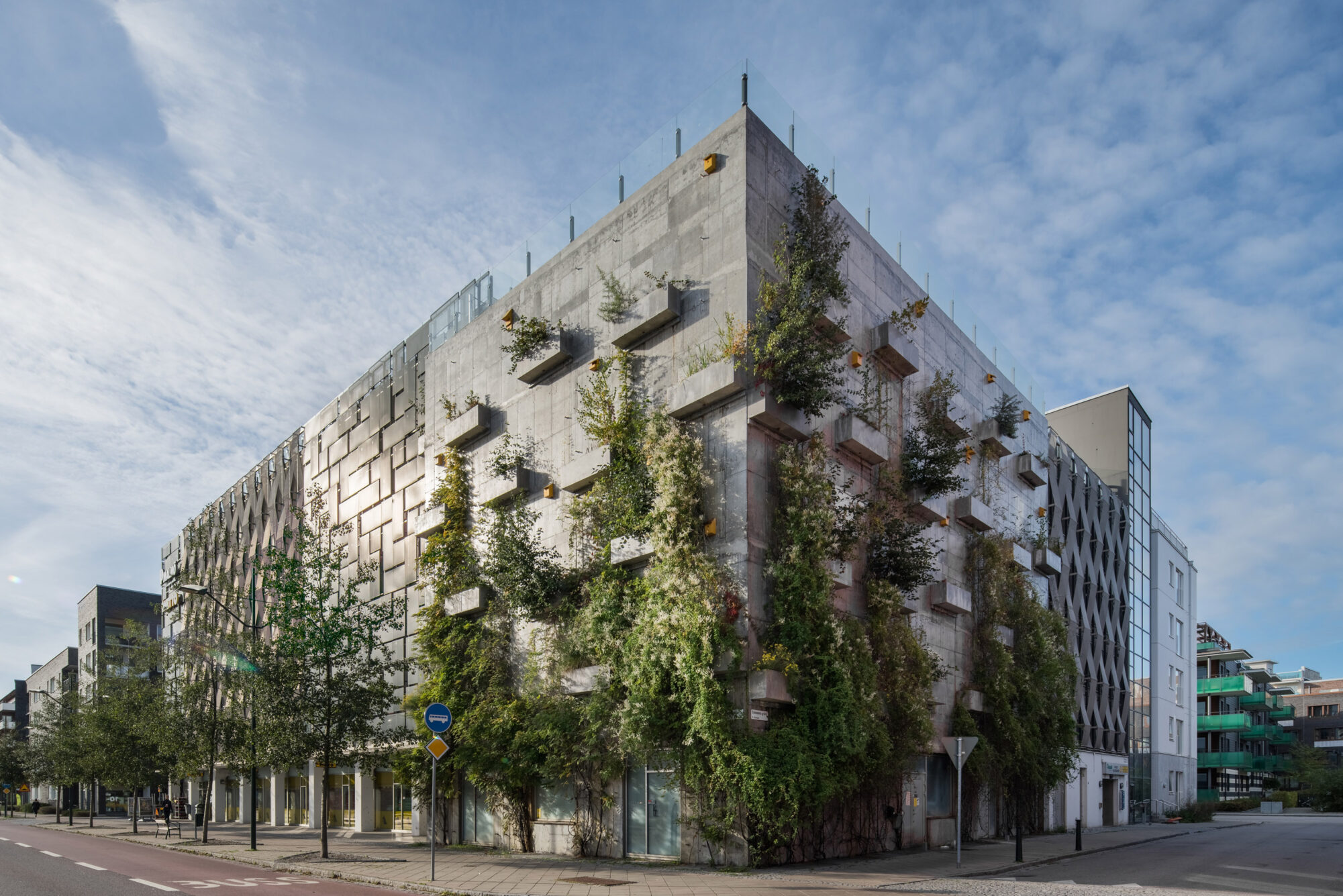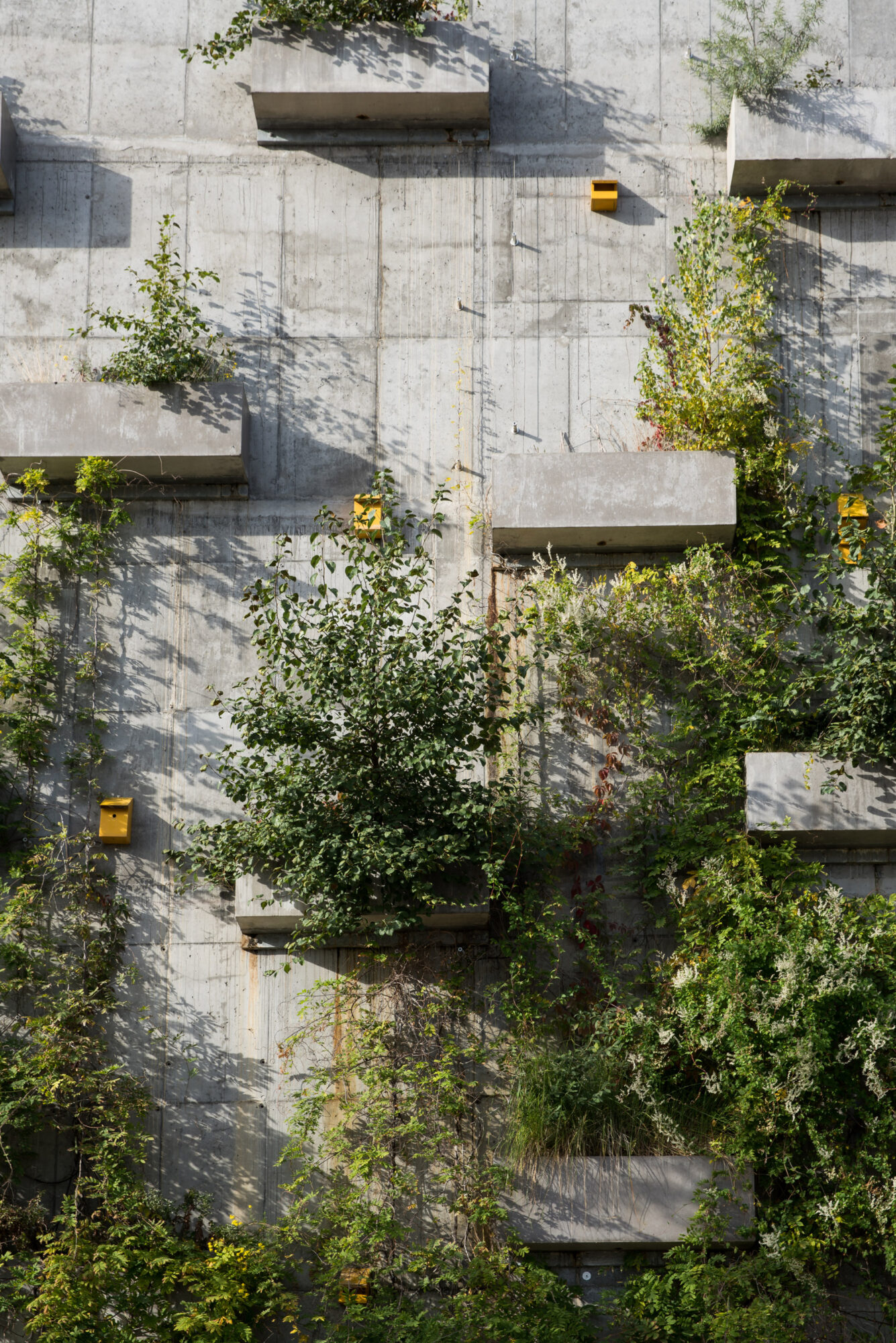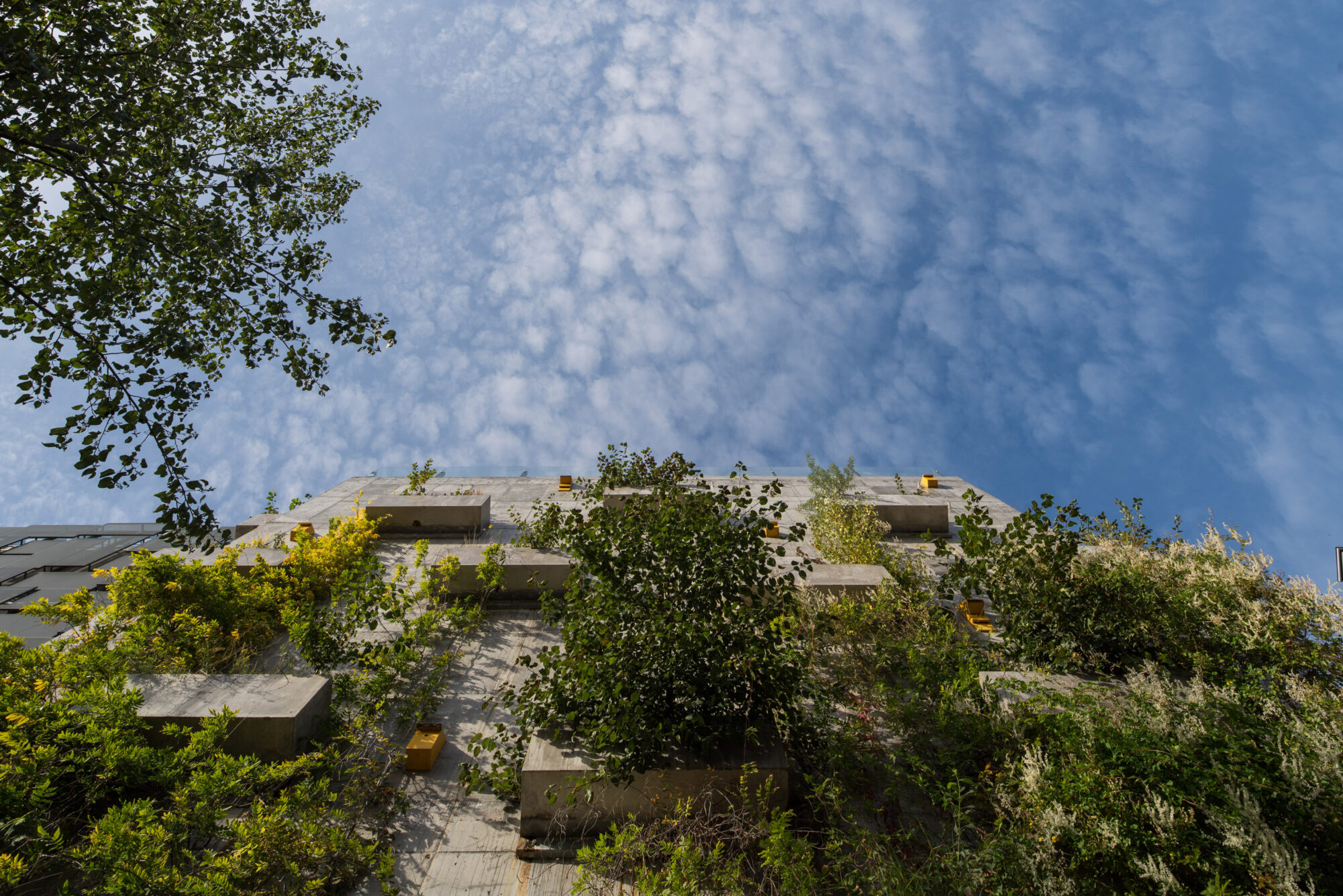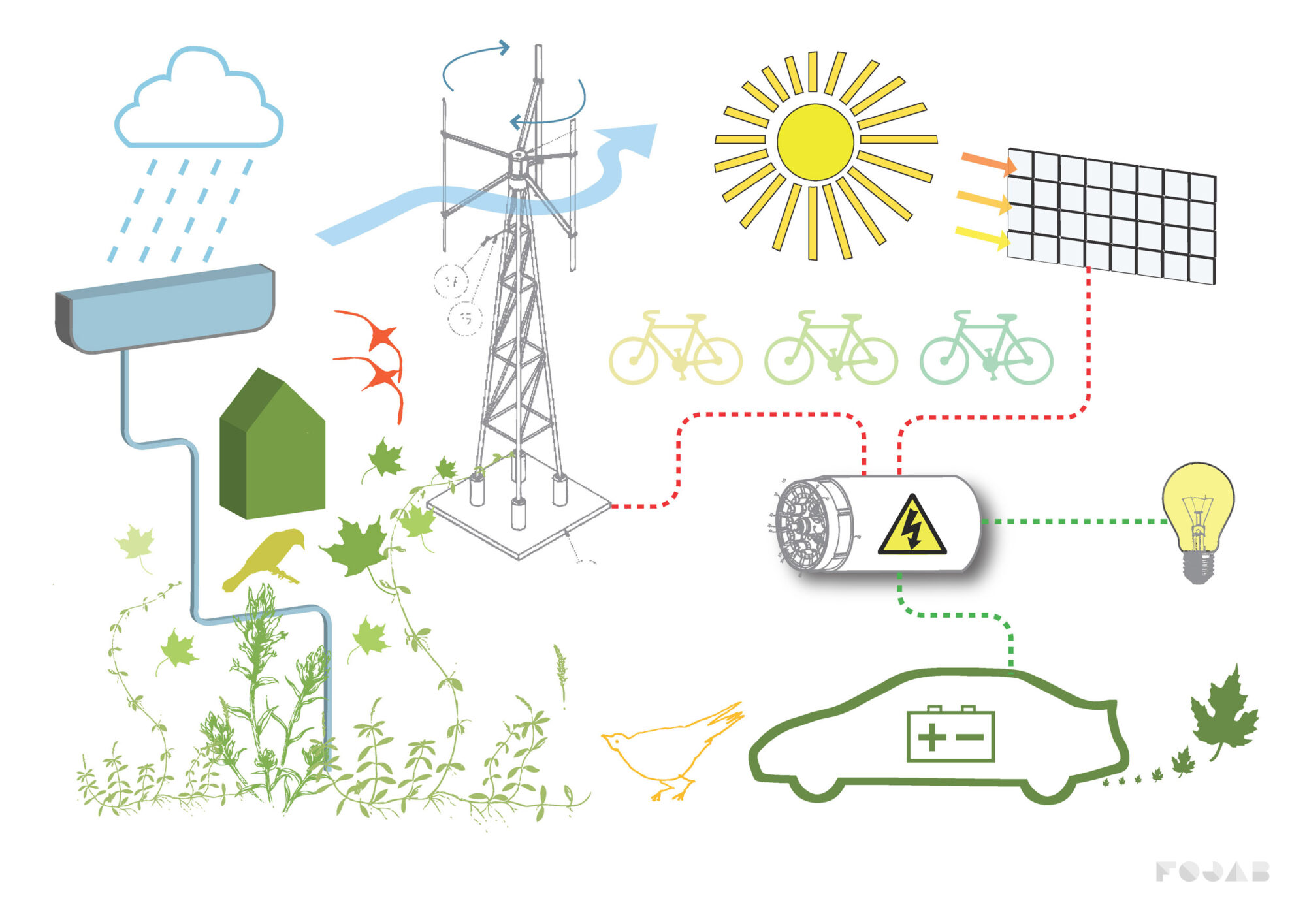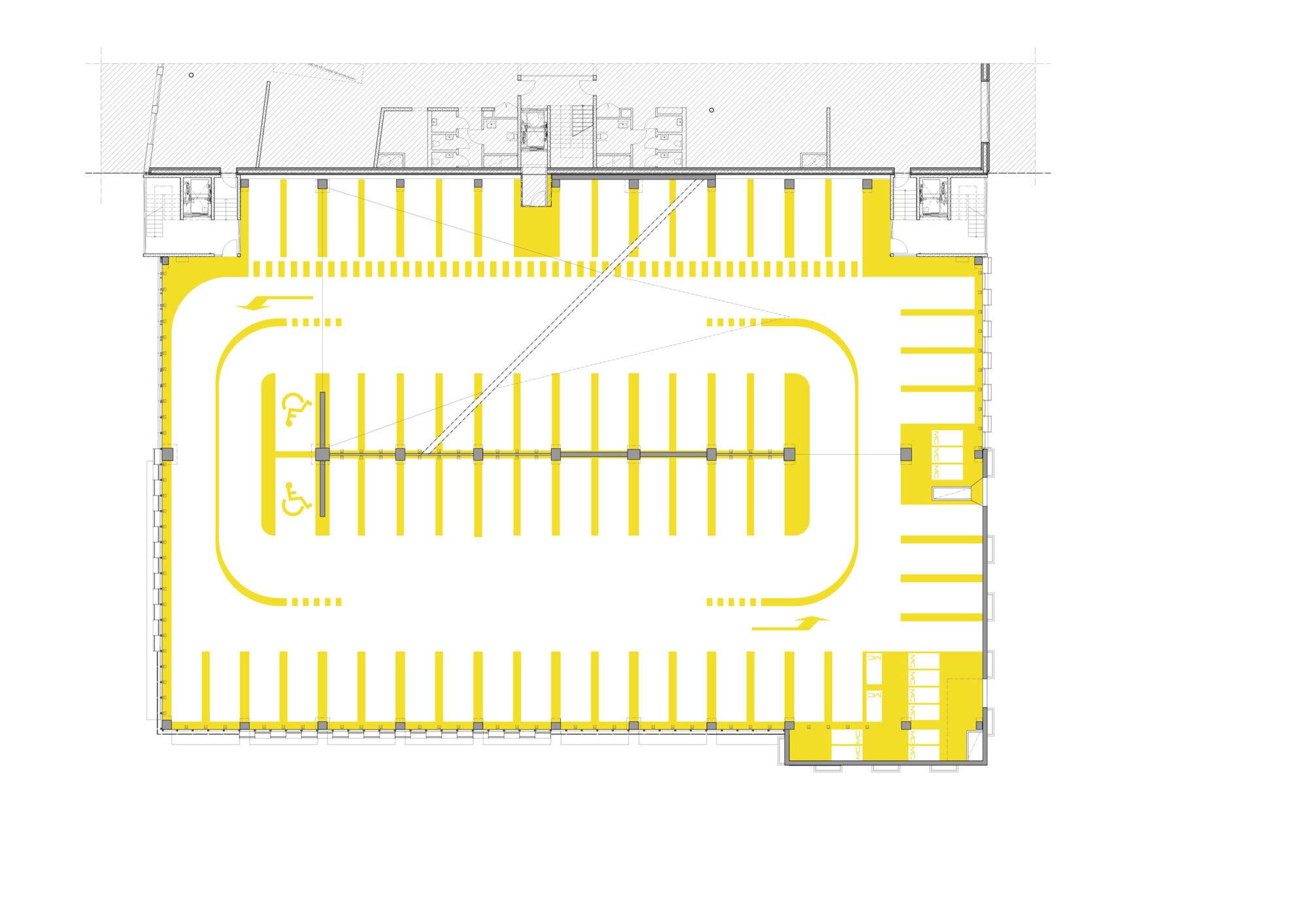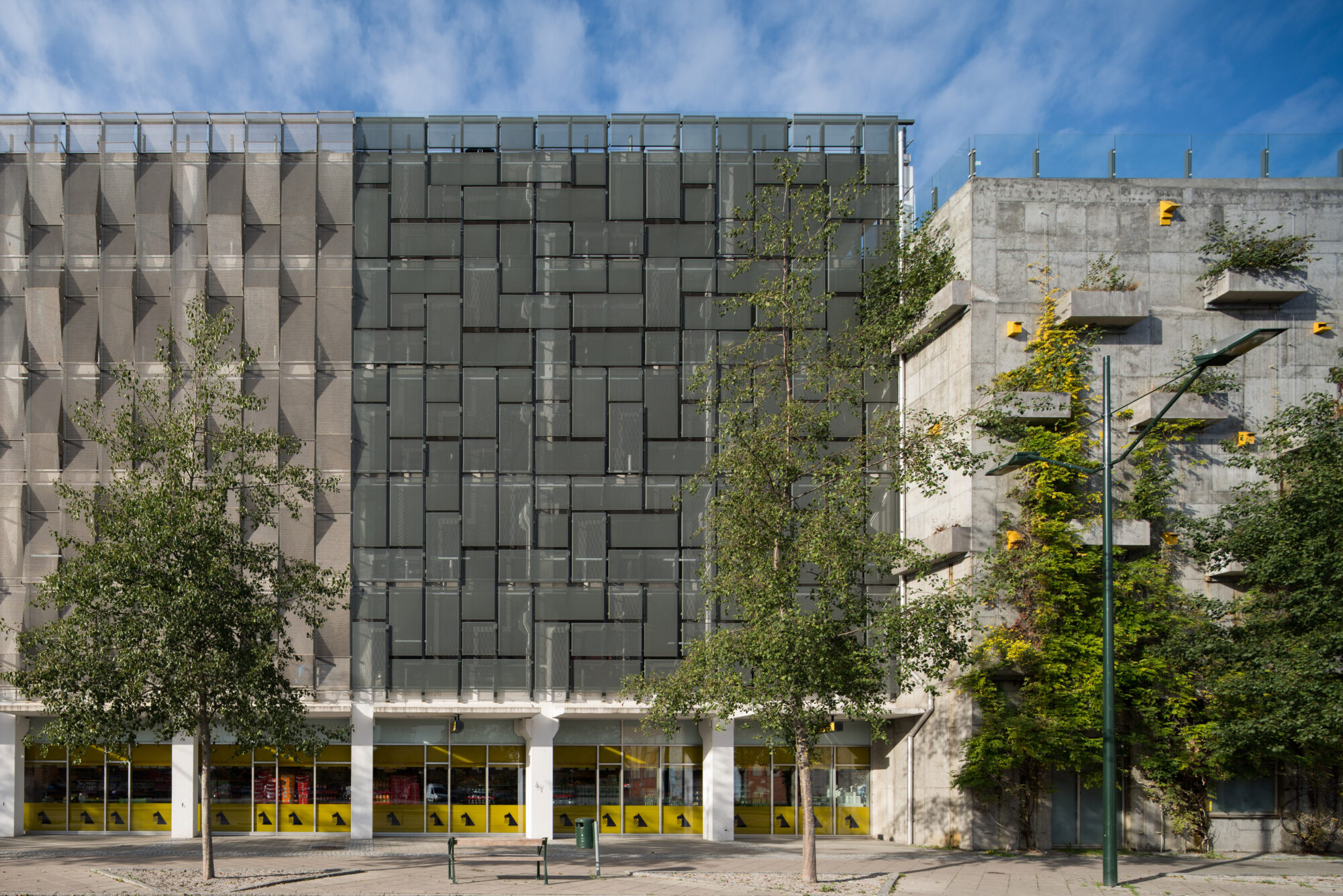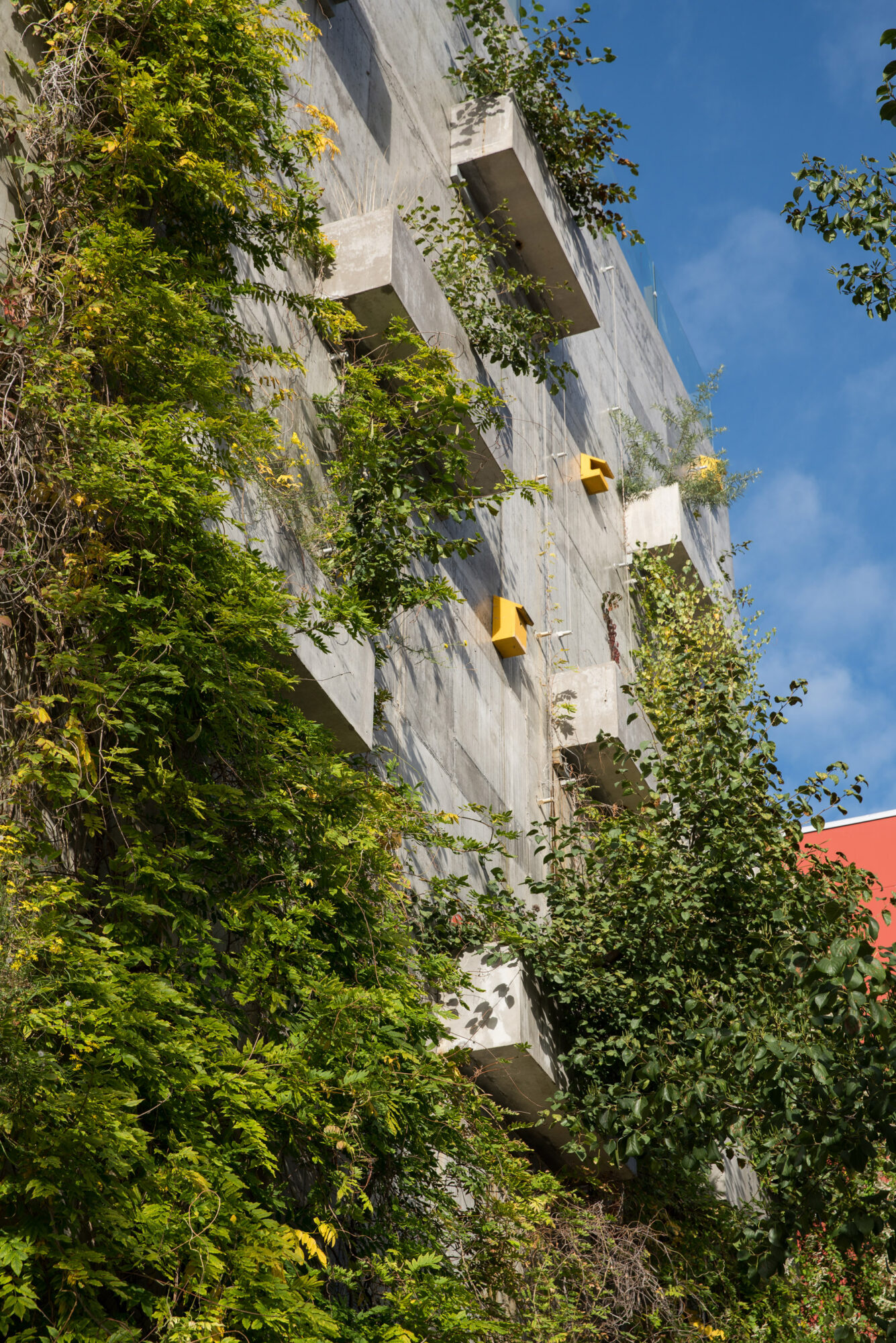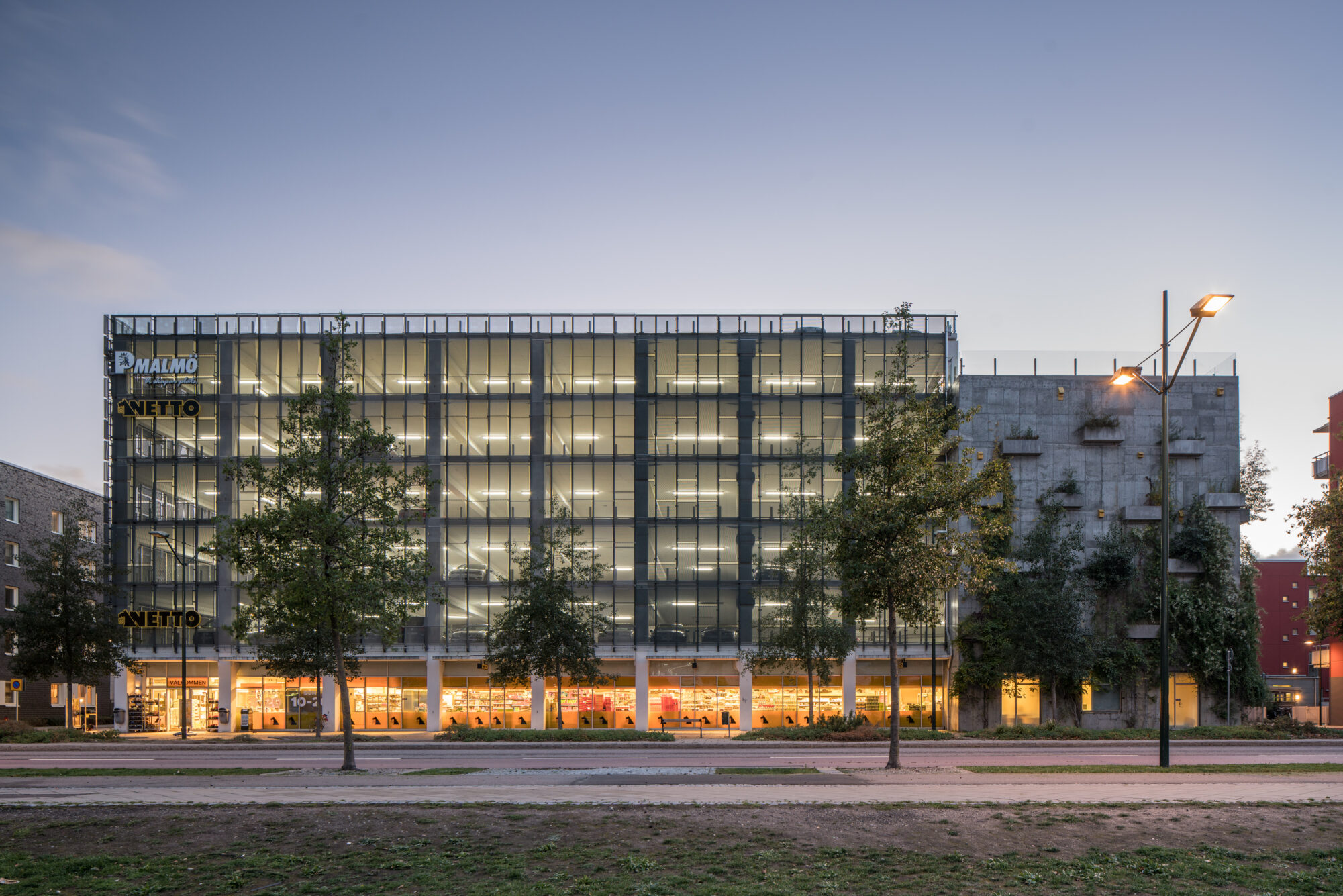Hyllieäng Mobility House
The Hyllieäng Mobility House, with its façade of used glass panels, leftover plates from heat exchangers and skeletons from the manufacturing industry, pushes the boundaries of reuse.
Hyllieäng is included as a pilot in the Vinnova project CC Build (Center for Circular Construction) as a reference project to demonstrate the possibilities of reusing and recycling materials.
The facade consists of panels made of recycled glass from the Orkanen building at Lärarhögskolan in Malmö and stainless steel sheets with laser-cut patterns. The plates are scrap waste from the manufacturing industry. The glass and sheets are assembled in the field according to four different compositions. Ivy climbs up the facade from ground plantings.
At street level, the building meets the neighborhood with an arcade of concrete columns. Inside the arcade, a wall curves forward to create small spaces and a more intimate street space. There is a room for businesses and space for micro-mobility solutions with rooms for workshops and bicycle rentals. The building is crowned by a photovoltaic system that generates locally produced electricity.
The undulating exterior walls at ground level are clad with corten and a scale panel of recycled sheet metal, which is waste material from the production of plate heat exchangers.
The 2,400 square meter facade is designed to be dismantled and the material used again once the mobility house has reached the end of its life. Therefore, all materials are kept as clean and raw as possible. The fastening system can also be easily dismantled.
Pottholmen
In a central location on Pottholmen, the new entrance to Karlskrona, a city block will be developed consisting of housing, nursing homes and mobility houses. We won the land allocation competition with a proposal that is multifaceted in both content and expression.
The Tower District with its housing, restaurants and outdoor seating, will be an eye-catcher and an inviting meeting point for both neighborhood community and city life. A new landmark in the city. We have placed great emphasis on place-making, conditions for public life and both quiet and lively meeting places.
Garden houses is a nursing home that combines forward-looking social care solutions with green and urban architecture. The buildings meet the city with soft gestures: a warm wooden façade and a small green square facing south. But the interior of the block and the roofscape are also green. The outdoor environment is designed to meet the needs of the residents and at the same time inspire movement and spending time in nature. The environment stimulates all the senses, arouses curiosity and inspires a sense of home.
When designing the nursing home, we focus a lot on visibility, light and orientation, which creates the conditions for putting the resident at the center while facilitating the work of the staff.
The port warehouse is a social mobility house that, with its red facade and arcade, connects to Karlskrona's oldest tradition, but accommodates a new program and new experiences. The façade provides a warm and sustainable expression with an exclamation mark: a public sauna where sweating Karlskrona residents can look out over the trains rolling in and out of the city. Along the façade of the mobility building facing the public transport square is an arcade with generous business premises. The arcade creates a rain-protected urban space that contributes to a flattened urban character.
The falu-red wooden facade lets the daylight in between the slats and feels so airy that you can look out from the parking level and orient yourself in the city. In the street spaces outside, the sparse wooden facade also creates an exciting play of light. On the roof, a large-scale pergola with solar panels spreads out. Energy from the solar panels is stored in battery rooms in the building and used locally to minimize the amount of purchased electricity. Areas that are not solar panels become green biotope roofs that retain stormwater.
Sun Quarter Mobility House
Kintsugi is the Japanese word for the tradition of repairing broken pottery with gold so that the crack helps to make the broken piece more beautiful.
In the Solkvarteret mobility building, we have decorated the horizontal cracks between the parking lots with an ornate metal grid. The area between the grid is covered with a bottle-green facade with active solar cells that make the building self-sufficient in energy for much of the year. On the ground floor there is a larger room, bicycle parking with changing rooms and showers, and a delivery center for e-commerce and grocery bags. The mobility house is built together with the Fabriken office building.
The Solar Quarter has been awarded the Skåne Solar Award 2022.
Dockan car park
P-huset Dockan is a mobility facility in central Västerås, with an innovative facade of three-dimensional aluminum panels. The facade consists of 378 bent sheets that together create undulating vertical lines and surfaces along the facade. The building's location by Lake Mälaren and its sparkling water surface has provided inspiration for an articulated and unique façade design, which captures and reflects the light of the sky.
At night, when the parking garage is illuminated, small perforated holes in the surface of the sheet metal appear as water splashes. The innovative bending technique has developed in prototype stage in close cooperation between FOJAB and Plåtexpressen, partly as a stand at Plåt16 in Gothenburg. The technology has now been taken forward to full-scale application by FOJAB and LW Sverige AB. In order to understand on the drawing board what the facade will look like when completed, and what shapes are possible to bend, a digital model of the bending process has been developed that simulates the actual behavior of the sheet metal. Using the bending technique, expressive facades can be created with relatively simple means in a resource-efficient way, and contribute to increased care in the built environment.
The Mobility House serves as a meeting place and identity builder for local areas, with a gym and bakery on the ground floor, car pool cars for sharing and a high proportion of parking spaces with the possibility to charge electric cars.
Award:
Finalist Sheet Metal Prize 2021
The deck
The deck is a parking facility with six levels above ground and one underground. All levels are sloped and there are good opportunities for charging electric and hybrid vehicles. In the design, great consideration has been given to security, which is reflected in lighting and glazed surfaces in the elevators, among other things. Entrances and stairwells are positioned for traffic safety and comfort.
The facades of the building are made of simple and robust materials that stand the test of time. The wood of the façade will slowly gray and merge with the cast-in-place concrete of the building. The facades of the parking lot are clad with rhombic trusses that support glulam and expanded metal, allowing the building to change character between day and night.
Towards the neighboring property, the facade consists of concrete with a matrix cast pattern. The structure of the facade is inspired by the structure of the sailcloth and connects to the site's contact with the water and the marina.
The ground floor is planned to house functions other than parking, such as the existing grocery store, which contributes to a vibrant urban environment.
Hyllie car park
The parking facility is close to Hyllie Station and therefore facilitates onward travel by train or bus.
There are 1,400 car spaces on nine levels and bicycle parking with 1,000 bicycle spaces on two levels. The parking garage is manned and has service, workshops, showers and a lounge directly adjacent to the train tracks. On the ground floor there are premises for, among other things, car wash and tire hotel and a monitoring center for P Malmö.
The façade consists of over 3,600 adjustable 'glass wings', which can be set in different patterns. To the east, the glass is made of diamond glass (non-ferrous glass) and has a ceramic double-sided print with pixelated autumn leaves. To the north, the glass is matt white on the outside and glossy black on the inside. The glasses have a square format in order to best create a pixelated image by placing the discs at different angles and obtaining shade differences in each pixel.
Behind the glass facades is a standing expanded metal fallout shelter that also helps to deflect the headlights of cars from adjacent buildings. To the south there is a plant wall with climbing plants.
The Hyllie parking garage was inaugurated when the City Tunnel in Malmö opened in 2010.
Full rigger
In Malmö's new Fullriggaren district, FOJAB has designed a parking garage with retail space on the ground floor.
The parking garage has a clear environmental profile that includes a solar cell façade, electric car parking and a car pool to which residents in the area have free membership for the first few years.
The facades of the building are made up of tensioned metal mesh, perforated sheets, and a concrete wall with climbing plants and yellow birdhouses - contributing to the greenery and biodiversity of the area.
